History of Western civilization: Difference between revisions
→Australia and New Zealand (1815-1870): autonomy + link to Waitangi |
→The Dominions (1870–1914): details |
||
| Line 288: | Line 288: | ||
Between 1870 and 1914, Britain continued to peacefully switch between [[Liberal Party (UK)|Liberal]] and [[Conservative Party (UK)|Conservative]] governments, and maintained its vast empire, the largest in world history. Two problems faced by Britain in this period were the resentment of British rule in Ireland and Britain's falling behind Germany and the United States in industrial production. |
Between 1870 and 1914, Britain continued to peacefully switch between [[Liberal Party (UK)|Liberal]] and [[Conservative Party (UK)|Conservative]] governments, and maintained its vast empire, the largest in world history. Two problems faced by Britain in this period were the resentment of British rule in Ireland and Britain's falling behind Germany and the United States in industrial production. |
||
===The Dominions (1870–1914)=== |
===The British Dominions (1870–1914)=== |
||
The populations of Canada, Australia, New Zealand and South Africa all continued to grow and thrive in this period. Canada united as a ''[[Dominion]]'' of the [[British Empire]] under the [[Constitution Act, 1867]] ([[British North America Acts]]). The colony of [[New Zealand]] gained its own Parliament (General Assembly) and home rule in 1852.<ref>{{cite web|url=http://www.teara.govt.nz/1966/H/HistoryConstitutional/TheLegislativeAuthorityOfTheNewZealand/en |title=History, Constitutional - The Legislative Authority of the New Zealand Parliament - 1966 Encyclopaedia of New Zealand |publisher=Teara.govt.nz |date=2009-04-22 |accessdate=2010-06-11}}</ref> and in 1907 was proclaimed the [[Dominion of New Zealand]].<ref name="nzhistory1">{{cite web|url=http://www.nzhistory.net.nz/politics/dominion-status |title=Dominion status |publisher=NZHistory |date= |accessdate=2010-06-11}}</ref> During the 1890s, the colonies of Australia voted to unite and in 1901 they were federated as an independent nation under the British Crown as the [[Commonwealth of Australia]]. The [[Heidelberg School]] of art adapted Western painting techniques to Australian conditions, while writers like [[Banjo Paterson]] and [[Henry Lawson]] introduced the character of a new continent into [[English literature]]. and Australians such as the Opera diva Dame [[Nellie Melba]] began to influence the European arts scene. The [[Constitution of Australia]] had been drafted in Australia and approved by popular consent. Thus Australia is one of the few countries established by a popular vote.<ref>D.Smith, Head of State, MaCleay Press 2005, p.18</ref> All of these lands became great centers of Western Civilization, each granting voting rights to their citizens in advance of most other Western nations (whith New Zealand and Australian parliaments becoming the first to extend [[women's suffrage|votes to women]] in the 1890s) Australia also saw such milestones as the invention of the [[secret ballot]], the introduction of a minimum wage, and the election of the world's first Labor Party government. |
|||
The populations of Canada, Australia, New Zealand and South Africa all continued to grow and thrive in this period. In 1856, Britain granted [[Dominion]] status to New Zealand, and in 1901 the Australian colonies were united to form a Dominion. All of these lands became great centers of Western Civilization. Australia granted voting rights to its citizens before Britain did, and New Zealand extended voting rights to women and provided its elderly with pensions. |
|||
===The New Alliances=== |
===The New Alliances=== |
||
Revision as of 09:18, 5 November 2010
This article needs additional citations for verification. (January 2009) |
The history of Western Civilization traces its roots back to classical antiquity and continues to the present era in Europe, North America and Oceania.

Antiquity (before AD 500)
The opposition of a European "West" to an Asiatic "East" has its roots in Classical Antiquity, with then Persian Wars where the Greek city states were opposing the expansion of the Achaemenid Empire. The Biblical opposition of Israel and Assyria from a European perspective was recast into these terms by early Christian authors such as Jerome, who compared it to the "barbarian" invasions of his own time (see also Assyria and Germany in Anglo-Israelism)
The "East" in the Hellenistic period was the Seleucid Empire, with Greek influence stretching as far as Bactria and India, besides Scythia in the Pontic steppe to the north. In this period, there was significant cultural contact between the Mediterranean and the East, giving rise to syncretisms like Greco-Buddhism. It was only with Christianization of the Roman Empire in the 4th century that the Mediterranean world lost interest in the Eastern cultures.

The division of Europe into a Western (Latin) and an Eastern (Greek) part was prefigured in the division of the Roman Empire by Diocletian in 285. The history of Christianity took divergent routes in these spheres from early times, but the final Great Schism separating Roman and Eastern Christianity occurred only in the 11th century.
In 476 AD the western Roman Empire, which had ruled modern-day Italy, France, Spain, Portugal and England for centuries collapsed due to a combination of economic decline, and drastically reduced military strength, allowing invasion by barbarian tribes originating in southern Scandinavia and modern-day northern Germany. According to many authors, the main causes for the fall of any empire are internal, such as racial, religious or political divisions within the country. Also, warfare and economic crisis may contribute to the empire's collapse. In England, several Germanic tribes invaded, including the Angles and Saxons. In Gaul (modern-day France, Belgium and parts of Switzerland) and Germania Inferior (The Netherlands), the Franks settled, in Iberia the Visigoths invaded and Italy was conquered by the Ostrogoths.
The Early Middle Ages (AD 500–1000)
Around 500 AD, Clovis I, the King of the Franks, became a Christian and united Gaul under his rule. Later in the 6th century, the Eastern Roman Empire restored its rule in much of Italy and Spain. Missionaries sent from Ireland and by the pope helped to convert England to Christianity in the 6th century as well, restoring that faith as the dominant in Western Europe.


In the 7th century Islam was founded in Arabia. An Islamic empire was established shortly afterwards and soon spread across the Middle East and North Africa. By the early 8th century, Iberia and Sicily had fallen to the Muslims. Only in 732 was the Muslim advance into Europe stopped by the Frankish leader Charles Martel, saving Gaul and the rest of the West from conquest by Islam. From this time, the "West" became synonymous with Christendom, the territory ruled by Christian powers, since Oriental Christianity had become reduced to dhimmi status under the Muslim Caliphates. The cause to liberate the "Holy Land" remained a major topos throughout medieval history, fuelling many consecutive crusades, only the first of which was successful.
Charlemagne ("Charles the Great" in English) became king of the Franks. He conquered the Low Countries (modern-day Belgium, the Netherlands, and Luxembourg), Germany, and northern and central Italy. In 800, Pope Leo III crowned Charlemagne Holy Roman Emperor. Under his rule, his subjects in non-Christian lands like Germany converted to Christianity. After his reign, the empire he created broke apart into the kingdom of France (from Francia meaning "land of the Franks") and the Holy Roman Empire.
Starting in the late 8th century, the Vikings began attacking the towns and villages of Europe. Eventually, they turned from raiding to conquest, and conquered Ireland, most of England, and northern France (Normandy). These conquests were not long-lasting, however. In 954 Alfred the Great drove the Vikings out of England, which he united under his rule, and Viking rule in Ireland ended as well. In Normandy the Vikings adopted French culture and language, became Christians and were absorbed into the native population. By the beginning of the 11th century Scandinavia was divided into three kingdoms, Norway, Sweden, and Denmark, all of which were Christian and part of Western civilization. In the 11th century Norse explorers reached Iceland, Greenland, and even North America, however only Iceland was successfully settled by the Norse.
In the 10th century another marauding group of warriors swept through Europe, the Magyars. They eventually settled in what is today Hungary, converted to Christianity and became the ancestors of the Hungarian people.
A West Slavic people, the Poles, formed a unified state by the 10th century and having adopted Christianity also in the 10th century [1][2] but with most Poles converting in the 11th century.
By the start of the second millennium AD, the West had become divided linguistically into three major groups. The Romance languages, based on Latin, the language of the Romans, the Germanic languages, and the Celtic languages. The most widely spoken Romance languages were French, Italian, Portuguese and Spanish. Four widely-spoken Germanic languages were English, German, Dutch, and Danish. Irish and Scots Gaelic were two widely-spoken Celtic languages in the British Isles.
The High Middle Ages (1000–1300)
By the year 1000 feudalism had because of the roman empire became the dominant social, economic and political system in the West. At the top of society was the monarch, who gave land to nobles in exchange for loyalty. The nobles gave land to vassals, who served as knights to defend their monarch or noble. Under the vassals were the peasants or serfs. The feudal system thrived as long as peasants needed protection by the nobility from invasions originating inside and outside of Europe. So as the 11th century progressed, the feudal system declined along with the threat of invasion.
In 1054, after centuries of strained relations between the eastern and western branches of Christianity, the Great Schism occurred over differences in doctrine, splitting the Christian world between the Catholic Church, centered in Rome and dominant in the West, and the Orthodox Church, centered in Constantinople, capital of the Byzantine Empire.
The Church was one of the most powerful, if not the most powerful institution in Medieval Europe. The Church helped found many of the great universities of Europe and sponsored art, music and architecture. As the Church grew more powerful and wealthy, many sought reform. The Dominican and Franciscan Orders were founded, which emphasized poverty and spirituality. Large Gothic cathedrals were constructed throughout Europe.
Relations between the major powers in Western society: the nobility, monarchy and clergy, sometimes produced conflict. If a monarch attempted to challenge church power, condemnation from the church could mean a total loss of support among the nobles, peasants, and other monarchs. As monarchies centralized their power as the Middle Ages progressed, nobles tried to maintain their own authority. An important example of this is England, whose monarch was forced to sign the Magna Carta creating the legislative body of Parliament which was made up of nobles and clergy, which limited royal power and laid the foundation for constitutional monarchy.
The last pagan land in Europe was converted to Christianity with the conversion of the Baltic peoples in the High Middle Ages, bringing them into Western civilization as well.
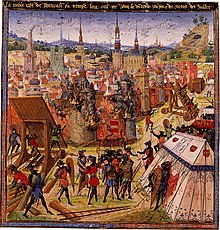
In 1095, Pope Urban II called for a Crusade to conquer the Holy Land from Muslim rule, when the Seljuk Turks prevented Christians from visiting the holy sites there. The crusade was a success and the crusaders established rule over the Holy Land. However, Muslim forces reconquered the land by the 13th century, and subsequent crusades were not very successful.
Philosophy in the High Middle Ages focused on religious topics. Christian Platonism, which modified Plato's idea of the separation between the ideal world of the forms and the imperfect world of their physical manifestations to the Christian division between the imperfect body and the higher soul was at first the dominant school of thought. However, in the 12th century the works of Aristotle were reintroduced to the West, which resulted in a new school of inquiry known as scholasticism, which emphasized scientific observation. Two important philosophers of this period were Saint Anselm and Saint Thomas Aquinas, both of whom were concerned with proving God's existence through philosophical means.
The Late Middle Ages and Early Renaissance (1300–1500)
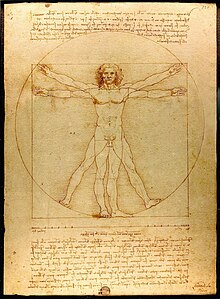

The last centuries of the Middle Ages saw the waging of the Hundred Years' War between England and France. The war began in 1337 when the king of France laid claim to English-ruled Gascony in southern France, and the king of England claimed to be the rightful king of France. At first, the English conquered half of France and seemed likely to win the war, until the French were rallied by a peasant girl, who would later become a saint, Joan of Arc. Although she was captured and executed by the English, the French fought on and won the war in 1453. After the war, France gained all of Normandy excluding the city of Calais, which it gained in 1558.
Another event to devastate Europe in the Later Middle Ages was the Black Plague, which arrived in the 14th century. Europe was overwhelmed by the plague, which was actually an outbreak of bubonic plague, probably brought to Europe by the Mongols who had conquered Kiev in eastern Europe in the 13th century. Up to a third of Europe's population died from the plague before it finally disappeared.
By the 14th century, the middle class in Europe had grown in influence and number as the feudal system declined. This spurred the growth of towns and cities in the West and improved the economy of Europe. This, in turn helped begin a cultural movement in the West known as the Renaissance, which began in Italy. Italy was dominated by city-states, many of which were nominally part of the Holy Roman Empire,and were ruled by wealthy aristocrats like the Medicis, or in some cases, by the pope.
The Renaissance ushered in a new age of scientific and intellectual inquiry and appreciation of ancient Greek and Roman civilizations. One important movement that resulted from the Renaissance was humanism, which placed importance on the study of human nature and worldly topics rather than religious ones. Important humanists of the time included the writers Petrarch and Boccaccio, who wrote in both Latin as had been done in the Middle Ages, as well as the vernacular, in their case Tuscan Italian. Important artists of the time included Leonardo da Vinci, Michelangelo Buonarroti and Raphael, whose works were more realistic-looking than those created by Medieval artists. Churches began being built in the Romanesque style for the first time in centuries.
Eventually, the Renaissance spread northwards to the rest of the West. Important artists of this period included Bosch, Dürer, and Breugel. In Spain Miguel de Cervantes wrote the novel Don Quixote, other important works of literature in this period were the Canterbury Tales by Geoffrey Chaucer and Le Morte d'Arthur by Sir Thomas Mallory. Around 1450, Johannes Gutenberg developed a printing press, which allowed works of literature to spread more quickly. Important thinkers of the Renaissance in Northern Europe included the Dutchman Desiderius Erasmus and the Englishman Thomas More.
Meanwhile, the Christian kingdoms of northern Iberia continued their centuries-long fight to reconquer the peninsula from its Muslim rulers. In 1492, the last Islamic stronghold, Granada, fell, and Iberia was divided between the Christian kingdoms of Spain and Portugal. Iberia's Jewish and Muslim minorities were forced to convert to Catholicism or be exiled. The Portuguese immediately looked to expand outward sending expeditions to explore the coasts of Africa and engage in trade with the mostly Muslim powers on the Indian Ocean, making Portugal wealthy. In 1492, a Spanish expedition of Christopher Columbus discovered the Americas during an attempt to find a western route to East Asia.
The Renaissance and Reformation (1500–1650)
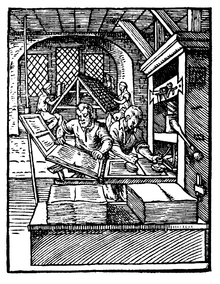
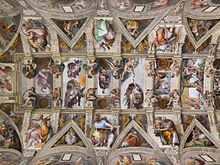

The 16th century saw the flowering of the Renaissance in the rest of the West. In Polish-Lithuanian Commonwealth the astronomer Nicolaus Copernicus deduced that the geocentric model of the universe was incorrect, and that in fact the planets revolve around the sun. The Italian astronomer Galileo developed telescope technology. Advances in medicine and understanding of the human anatomy also increased in this time. In England, Sir Isaac Newton pioneered the science of physics. These events led to the so-called scientific revolution, which emphasized experimentation. The most famous playwright of the era was the Englishman William Shakespeare.
The other major movement in the West in the 16th century was the Reformation, which would profoundly change the West and end its religious unity. The Reformation began in 1517 when the Catholic monk Martin Luther wrote his 95 Theses, which denounced the wealth and corruption of the church, as well as many Catholic beliefs, including the institution of the papacy and the belief that, in addition to faith in Christ, "good works" were also necessary for salvation. Luther drew on the beliefs of earlier church critics, like the Bohemian Jan Hus and the Englishman John Wycliffe. Luther's beliefs eventually ended in his excommunication from the Catholic Church and the founding of a church based on his teachings: the Lutheran Church, which became the majority religion in northern Germany. Soon other reformers emerged, and their followers became known as Protestants. In 1525, Ducal Prussia became the first Lutheran state.
In the 1540s the Frenchman John Calvin founded a church in Geneva which forbade alcohol and dancing, and which taught God had selected those destined to be saved from the beginning of time. His Calvinist Church gained about half of Switzerland and churches based on his teachings became dominant in the Netherlands (the Dutch Reformed Church) and Scotland (the Presbyterian Church). In England, King Henry VIII declared the Church of England or Anglican Church with himself as its leader when the pope refused to grant him a divorce. Some Englishmen felt the church was still too similar to the Catholic Church and formed the more radical Puritan Church. Many other small Protestant sects were formed, including Zwinglianism, Anabaptism and Mennonism. Although they were different in many ways, Protestants generally called their religious leaders ministers instead of priests, and believed only the Bible, and not Tradition offered divine revelation. Catholics countered the Reformation with the Catholic Reformation, which rooted out corruption in the church. An important leader in this movement was Ignatius of Loyola, founder of the Society of Jesus, an order of priests which gained many converts to the Catholic Church.
Religious wars erupted throughout Europe, especially in the Holy Roman Empire. Emperor Charles V was able to arrange the Peace of Augsburg between the warring Catholic and Protestant nobility. However, in 1618, the Thirty Years' War began between Protestants and Catholics in the empire, which eventually involved neighboring countries like France. The devastating war finally ended in 1648. In the Peace of Westphalia ending the war, Lutheranism, Catholicism and Calvinism were all granted toleration in the empire. The two major centers of power in the empire after the war were Protestant Prussia in the north and Catholic Austria in the south. The Dutch, who were ruled by the Spanish at the time, revolted and gained independence, founding a Protestant country. In 1588 the staunchly Catholic Spanish attempted to conquer Protestant England with a large fleet of ships called the Spanish Armada, however a storm destroyed the fleet, saving England.
By 1650, the religious map of Europe had been redrawn. Scandinavia, Iceland, north Germany, part of Switzerland, the Netherlands and Britain were Protestant, while the rest of the West remained Catholic.
The rise of Western empires (1500–1800)
From its dawn until modern times, the West had suffered invasions from Africa, Asia, and non-Western parts of Europe. By 1500 Westerners took advantage of their new technologies, expand their power, and become the first civilization to exert influence on the entire planet. Western explorers like Vasco da Gama, Christopher Columbus, James Cook, and Ferdinand Magellan (Fernão de Magalhães) charted lands previously unknown both to the West and the Old World as a whole.
The area of the world most affected by European expansion in modern times was the Americas. The Spanish, whose expedition under Columbus had discovered the New World (as the Americas were called by Europeans), conquered most of the Caribbean islands and advanced onto the mainland conquering the two great New World empires, the Aztec Empire of Mexico and the Inca Empire of Peru. From there, Spain conquered about half of South America and much of North America. The leaders of this conquest were called conquistadors (Spanish for conquerors). Portugal also expanded in the Americas, conquering half of South America and calling their colony Brazil. These Western powers were aided not only by superior technology like gunpowder in their conquests but also by Old World diseases which they inadvertently brought with them, which wiped out large segments Americas' Amerindian population. The natives populations, called Indians by Columbus, since he originally thought he had landed in Asia, but who are often called Amerindians by scholars today, were converted to Catholicism and adopted the language of their rulers, either Spanish or Portuguese. They also adopted much of Western culture. Many Iberian settlers arrived, and many of them intermarried with the Amerindians resulting in a so-called Mestizo population, which became the majority of the population of Spain and Portugal's American empires. Although Church leaders and the monarchy tried to treat the Amerindians with respect, their colonial rulers were often brutal. [citation needed]
Other powers to arrive in the Americas were the Swedes, Dutch, English, and French. The Dutch, English, and French all established colonies in the Caribbean and each established a small South American colony. The French established two large colonies in North America, Louisiana in the center of the continent and New France in the northeast of the continent. The French were not as intrusive as the Iberians were and had relatively good relations with the Amerindians, although there were areas of relatively heavy settlement like New Orleans and Quebec. Many French missionaries were successful in converting Amerindians to Catholicism. On North America's Atlantic coast, the Swedes established New Sweden. This colony was eventually conquered by the nearby Dutch colony of New Netherland. New Netherland itself was eventually conquered by England and renamed New York. Although England's American empire began in what is today Canada, they soon focused their attention to the south, where they established thirteen colonies on North America's Atlantic coast. The English were unique in that rather than attempting to convert the Amerindians, they simply settled their colonies with Englishmen and pushed the Amerindians off their lands.
Contact between the Old and New Worlds produced the Columbian Exchange, named after Columbus. It involved the transfer of goods unique to one hemisphere to another. Westerners brought cattle, horses, and sheep to the New World, and from the New World Europeans received tobacco, potatoes, and bananas. Other items becoming important in global trade were the sugarcane and cotton crops of the Americas, and the gold and silver brought from the Americas not only to Europe but elsewhere in the Old World.
Much of the land of the Americas was uncultivated, and Western powers were determined to make use of it. At the same time, tribal West African rulers were eager to trade their prisoners of war, and even members of their own tribes as slaves to the West. The West began purchasing slaves in large numbers and sending them to the Americas. This slavery was unique in world history for several reasons. Firstly, since only black Africans were enslaved, a racial component entered into Western slavery which had not existed in any other society to the extent it did in the West. Another important difference between slavery in the West and slavery elsewhere was the treatment of slaves. Unlike in some other cultures, slaves in the West were used primarily as field workers. Western empires differed in how often manumission was granted to slaves, with it being rather common in Spanish colonies, for example, but rare in English ones. Many Westerners did eventually come to question the morality of slavery. This early anti-slavery movement, mostly among clergy and political thinkers, was countered by pro-slavery forces by the introduction of the idea that blacks were inferior to European whites, mostly because they were non-Christians, and therefore it was acceptable to treat them without dignity. This idea resulted in racism in the West, as people began feeling all blacks were inferior to whites, regardless of their religion. Once in the Americas, blacks adopted much of Western culture and the languages of their masters. They also converted to Christianity.
After trading with African rulers for some time, Westerners began establishing colonies in Africa. The Portuguese conquered ports in what is today Angola and Mozambique. They also established relations with the Kingdom of Kongo in central Africa, and eventually the Kongolese converted to Catholicism. The Dutch established colonies in modern-day South Africa, which attracted many Dutch settlers. Western powers also established colonies in West Africa. However, most of the continent remained unknown to Westerners and their colonies were restricted to Africa's coasts.

Westerners also expanded in Asia. The Portuguese controlled port cities in the East Indies, India, Persian Gulf, Sri Lanka and China. During this time, the Dutch began their colonisation of the Indonesian archipelago, which became the Dutch East Indies in the early 19th century, and gained port cities in Sri Lanka and Malaysia. Spain conquered the Philippines and converted the inhabitants to Catholicism. Missionaries from Iberia gained many converts in Japan until Christianity was outlawed by Japan's emperor. Some Chinese also became Christian, although most did not. Most of India was divided up between England and France.
The Pacific Ocean was also explored by Europeans. The Dutch discovered Australia and New Zealand, while the English explored the Hawaiian, or as they were called at the time, the Sandwich Islands and Tahiti.
As Western powers expanded they competed for land and resources. In the Caribbean, pirates attacked each other and the navies and colonial cities of countries, in hopes of stealing gold and other valuables from a ship or city . This was sometimes supported by governments. For example, England supported the pirate Sir Francis Drake in raids against the Spanish. Between 1652 and 1678, the Anglo-Dutch wars were fought, which England won, and England gained New Netherland and Dutch South Africa. In 1756, the Seven Years' War, or French and Indian War began. It involved several powers fighting on several continents. In North America, English soldiers and colonial troops defeated the French, and in India the French were also defeated by England. In Europe Prussia defeated Austria. When the war ended in 1763, New France and eastern Louisiana were ceded to England, while western Louisiana was given to Spain. France's lands in India were ceded to England. Prussia was given rule over more territory in what is today Germany.
Europe's period of expansion in early modern times greatly changed the world. New crops from the Americas improved European diets. This, combined with an improved economy thanks to Europe's new network of colonies, led to a demographic revolution in the West, with infant mortality dropping, and Europeans getting married younger and having more children. The West became more sophisticated economically, adopting Mercantilism, in which companies were state-owned and colonies existed for the good of the mother country.
Absolutism and Enlightenment (1500–1800)

The West in the early modern era went through great changes as the traditional balance between monarchy, nobility and clergy shifted. With the feudal system all but gone, nobles lost their traditional source of power. Meanwhile, in Protestant countries, the church was now often headed by a monarch, while in Catholic countries, conflicts between monarchs and the Church rarely occurred and monarchs were able to wield greater power than they ever had in Western history. Monarchs during this time referred to their divine right to rule, claiming they were answerable only to God. This new style of rule is often called absolutism by historians.
In the opening years of the century, Europe was under threat from the Muslim Ottoman Turks. They had migrated from central to western Asia and converted to Islam years earlier. In 1453, after years of warfare, they conquered the Byzantine Empire and established the Ottoman Empire under their sultan. From their capital of Istanbul (what they renamed Constantinople), they expanded across the Middle East and North Africa. They then turned their attention to conquering the West. Under the leadership of the Spanish, a Christian coalition destroyed the Ottoman navy at the battle of Lepanto in 1571 ending their naval control of the Mediterranean. However, the Ottoman threat to Europe was not ended until a Polish lead coalition defeated the Ottoman at the Battle of Vienna in 1683[3][4].
The 16th century is often called Spain's Siglo de Oro (golden century). From its colonies in the Americas it gained large quantities of gold and silver, which helped make Spain the richest and most powerful 16th century Western nation. After Spain began to decline in the 17th century, the Dutch became the greatest world power, leading the 17th century to be called the Netherlands' golden age. After the Anglo-Dutch Wars, France and England emerged as the two greatest powers in the 18th century.
One of the greatest Spanish monarchs of the era was Charles I (1516–1556, who also held the title of Holy Roman Emperor Charles V). His attempt to unite these lands was thwarted by the divisions caused by the Reformation and ambitions of local rulers and rival rulers from other countries. Another great monarch was Philip II (1556–1598), whose reign was marked by several Reformation conflicts, like the loss of the Netherlands and the Spanish Armada. These events and an excess of spending would lead to a great decline in Spanish power and influence by the 17th century.
Louis XIV became king of France in 1643. His reign was one of the most opulent in European history. He built a gigantic palace in the town of Versailles.
The Holy Roman Emperor exerted no great influence on the lands of the Holy Roman Empire by the end of the Thirty Years' War. In the north of the empire, Prussia emerged as a powerful Protestant nation. Under many gifted rulers, like King Frederick the Great, Prussia expanded its power and defeated its rival Austria many times in war. Ruled by the Habsburg dynasty, Austria became a great empire, expanding at the expense of the Ottoman Empire and Hungary.
One land where absolutism did not take hold was England. Elizabeth I, daughter of Henry VIII, had left no direct heir to the throne. The rightful heir was actually James VI of Scotland, who was crowned James I of England. James's son, Charles I resisted the power of Parliament. When Charles attempted to shut down Parliament, the Parliamentarians rose up and soon the all of England was involved in a civil war. The English Civil War ended in 1649 with the defeat and execution of Charles I. Parliament declared a republic but soon appointed the anti-absolutist leader and staunch Puritan Oliver Cromwell as Lord Protector. Cromwell enacted many unpopular Puritan religious laws in England, like outlawing alcohol and theaters. After his death, the monarchy was restored under Charles's son, who was crowned Charles II. His son, James II succeeded him. James and his infant son were Catholics. Not wanting to be ruled by a Catholic dynasty, Parliament invited James's daughter Mary and her husband William of Orange, to rule as co-monarchs. They agreed on the condition James would not be harmed. Realizing he could not count on the Protestant English army to defend him, he abdicated in 1688. Before William and Mary were crowned however, Parliament forced them to sign the English Bill of Rights, which guaranteed some basic rights to all Englishmen, granted religious freedom to non-Anglican Protestants, and firmly established the rights of Parliament. In 1707, the Act of Union of 1707 were passed by the parliaments of Scotland and England, merging Scotland and England into a single United Kingdom of Great Britain, with a single, united parliament. This kingdom also controlled Ireland which had previously benn conquored by England, and in 1801 Ireland formally merged with the United Kingdom. Although it eventually became an English-speaking land, Ireland preserved its own culture and religious outlook, remaining Catholic.

An intellectual movement called the Enlightenment began in this period as well. Its proponents opposed the absolute rule of the monarchs of their day, and instead emphasized the equality of all individuals and the idea that governments derived their existence from the consent of the governed. Enlightenment thinkers called philosophes (French for philosophers) idealized Europe's classical heritage. They looked at Athenian democracy and the Roman republic as ideal governments. They believed reason held the key to creating an ideal society. In 1690 the Englishman John Locke wrote that people have certain natural rights like life, liberty and property and that governments were created in order to protect these rights. If they did not, according to Locke, the people had a right to overthrow their government. The French philosopher Voltaire criticized the monarchy and the Church for what he saw as hypocrisy and for their persecution of people of other faiths. Another Frenchman, Montesquieu, advocated division of government into executive, legislative and judicial branches. The French author Rousseau stated in his works that society corrupted individuals. Another important writer of this time was the Scot Adam Smith, who believed competition and private enterprise could increase the common good. Many monarchs were affected by these ideas, and they became known to history as the enlightened despots. However, most only supported Enlightenment ideas that strengthened their own power.
European cities like Paris, London, and Vienna grew into large metropolises in early modern times. France became the cultural center of the West. The middle class grew even more influential and wealthy. Great artists of this period included El Greco, Rembrandt, and Caravaggio.
By this time, many around the world wondered how the West had become so advanced, for example, the Orthodox Christian Russians, who came to power after conquering the Mongols that had conquered Kiev in the Middle Ages. They began westernizing under Czar Peter the Great, although Russia remained uniquely part of its own civilization. The Russians became involved in European politics, dividing up the kingdom of Poland-Lithuania with Prussia and Austria.
Philosophy in this period was dominated by several thinkers. The Englishman Francis Bacon espoused the idea that senses should be the primary means of knowing, while the Frenchman René Descartes advocated using reason over the senses. In his works, Descartes was concerned with using reason to prove his own existence and the existence of the external world, including God. Another belief system became popular among philosophes, Deism, which taught that a single god had created but did not interfere with the world. This belief system never gained popular support and largely died out by the early 19th century.
An age of revolution (1770–1815)
The late 18th century and early 19th century in the West were dominated by a series of revolutions that would change the West forever, resulting in new ideologies and changes in society.
The first of these revolutions began in North America. Britain's 13 American colonies had by this time developed their own sophisticated economy and culture, largely based on Britain's. The majority of the population was of British descent, while significant minorities included people of Irish, Dutch and German descent, as well as some Amerindians and many black slaves. Most of the population was Anglican, others were Congregationalist or Puritan, while minorities included other Protestant churches like the Society of Friends and the Lutherans, as well as some Roman Catholics. The colonies had their own great cities and universities and continually welcomed new immigrants, mostly from Britain. After the expense Seven Years' War, Britain needed to raise revenue, and felt the colonists should bare the brunt of the new taxation it felt was necessary. The colonists greatly resented these taxes and protested the fact they could be taxed by Britain but had no representation in the government.

After Britain's King George III refused to seriously consider colonial grievances raised at the first Continental Congress, some colonists took up arms. Leaders of a new pro-independence movement were influenced by Enlightenment ideals and hoped to bring an ideal nation into existence. On July 4, 1776, the colonies declared independence with the signing of the United States Declaration of Independence. George Washington led the new Continental Army against the British forces, who had many successes early in this American Revolution. After years of fighting, the colonists formed an alliance with France and defeated the British at Yorktown, Virginia in 1781. The treaty ending the war granted independence to the colonies, which became The United States of America.
The other major Western revolution at the turn of the 19th century was the French Revolution. In 1789 France faced an economical crisis. The King called, for the first time in more than two centuries, the Estates General, an assembly of representatives of each estate of the kingdom: the First Estate (the clergy), the Second Estate (the nobility), and the Third Estate (middle class and peasants); in order to deal with the crisis. As the French society was gained by the same Enlightenment ideals that led to the American revolution, in which many Frenchmen, such as Lafayette, took part; representatives of the Third Esatate, joined by some representatives of the lower clergy, created the National Assembly, which, unlike the Estates General, provided the common people of France with a voice proportionate to their numbers.
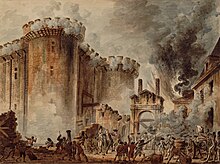
The people of Paris feared the King would try to stop the work of the National Assembly and Paris was soon consumed with riots, anarchy, and widespread looting. The mobs soon had the support of the French Guard, including arms and trained soldiers, because the royal leadership essentially abandoned the city. On the fourteenth of July 1789 a mob stormed the Bastille, a prison fortress, which led the King to accept the changes. On 4 August 1789 the National Constituent Assembly abolished feudalism sweeping away both the seigneurial rights of the Second Estate and the tithes gathered by the First Estate. It was the first time in Europe, where feudalism was the norm for centuries, that such a thing happened. In the course of a few hours, nobles, clergy, towns, provinces, companies, and cities lost their special privileges.
At first, the revolution seemed to be turning France into a constitutional monarchy, but the other continental Europe powers feared a spread of the revolutionary ideals and eventually went to war with France. In 1792 King Louis XVI was imprisoned after he had been captured fleeing Paris and the Republic was declared. The Imperial and Prussian armies threatened retaliation on the French population should it resist their advance or the reinstatement of the monarchy. As a consequence, King Louis was seen as conspiring with the enemies of France. His 21 January 1793 execution led to more wars with other European countries. During this period France effectively became a dictatorship after the parliamentary coup of the radical leaders, the Jacobin. Their leader, Robespierre oversaw the Reign of Terror, in which thousands of people deemed disloyal to the republic were executed. Finally, in 1794, Robespierre himself was arrested and executed, and more moderate deputies took power. This led to a new government, the French Directory. In 1799, a coup overthrew the Directory and General Napoleon Bonaparte seized power as dictator and even an emperor in 1804.
During all that period France had to fight on multiple battlefronts against the other European powers. A nationwide conscription was voted to reinforce the old royal army made of noble officers and professional soldiers. With this new kind of army Napoleon was able to beat the European allies and dominate Europe. The revolutionary ideals, based no more on feudalism but on the concept of a sovereign nation, spread all over Europe. When Napoleon eventually lost and the monarchy reinstated in France these ideals survived and led to the revolutionary waves of the 19th century that bring democracy in many European countries.
With the success of the American Revolution, the Spanish Empire also began to crumble as their American colonies sought independence as well. In 1808, when Joseph Bonaparte was installed as the Spanish King by the Napoleonic French, the Spanish resistance resorted to governing Juntas. When the Supreme Central Junta of Seville fell to the French in 1810, the Spanish American colonies developed themselves governing Juntas in the name of the deposed King Ferdinand VII (upon the concept known as "Retroversion of the Sovereignty to the People"). As this process led to open conflicts between independentists and loyalists, the Spanish American Independence Wars immediately ensued; resulting, by the 1820s, in the definitive loss for the Spanish Empire of all its American territories, with the exception of Cuba and Puerto Rico.
The rise of the English-speaking world (1815–1870)
The years following Britain's victory in the Napoleonic Wars were a period of expansion for the United Kingdom and its former American colonies, which now made up the United States. This period of expansion would help establish Anglicanism as the dominant religion, English as the dominant language, and English and Anglo-American culture as the dominant culture of two continents and many other lands outside the British Isles.
The Industrial Revolution in the English-speaking world

Possibly the greatest change in the English-speaking world and the West as a whole following the Napoleonic Wars was the Industrial Revolution. The revolution began in Britain, where Thomas Newcomen developed a steam engine in 1712 to pump seeping water out of mines. This engine at first was powered by water, but later other fuels like coal and wood were used. Steam power had first been developed by the Ancient Greeks, but it was the British that first learned to use steam power effectively. In 1804, the first steam powered railroad locomotive was developed in Britain, which allowed goods and people to be transported at faster speeds than ever before in history. Soon, large numbers of goods were being produced in factories. This resulted in great societal changes, and many people settled in the cities where the factories were located. Factory work could often be brutal. With no safety regulations, people became sick from contaminants in the air in textile mills for, example. Many workers were also horribly maimed by dangerous factory machinery. Since workers relied only on their small wages for sustenance, entire families were forced to work, including children. These and other problems caused by industrialism resulted in some reforms by the mid-19th century. The economic model of the West also began to change, with mercantilism being replaced by capitalism, in which companies, and later, large corporations, were run by individual investor(s).
New ideological movements began as a result of the Industrial Revolution, including the Luddite movement, which opposed machinery, feeling it did not benefit the common good, and the socialists, whose beliefs usually included the elimination of private property and the sharing of industrial wealth. Unions were founded among industrial workers to help secure better wages and rights. Another result of the revolution was a change in societal hierarchy, especially in Europe, where nobility still occupied a high level on the social ladder. Capitalists emerged as a new powerful group, with educated professionals like doctors and lawyers under them, and the various industrial workers at the bottom. These changes were often slow however, with Western society as a whole remaining primarily agricultural for decades.
The United Kingdom (1815–1870)

From 1837 until 1901, Britain was ruled by Queen Victoria, arguably the most popular of all British monarchs in history. Her reign oversaw the establishment of a great empire and Britain's becoming the most powerful Western nation. Britain also enjoyed relative peace from 1815 until 1914, this period is often called the Pax Britannica, from the Latin "British Peace". This period also saw the evolution of British constitutional monarchy, with the monarch being more a figurehead and symbol of national identity than actual head of state, with that role being taken over by the Prime Minister, the leader of the ruling party in Parliament. Two dominant parties emerging in Parliament in this time were the Conservative Party and the Liberal Party. The Liberal constituency was made up of mostly of businessmen, as many Liberals supported the idea of a free market. Conservatives were supported by the aristocracy and farmers. Control of Parliament switched between the parties over the 19th century, but overall the century was a period of reform. In 1832 more representation was granted to new industrial cities, and laws barring Catholics from serving in Parliament were repealed, although discrimination against Catholics, especially Irish Catholics, continued. Other reforms granted near universal manhood suffrage, and state-supported elementary education for all Britons. More rights were granted to workers as well.
Ireland had been ruled from London since the Middle Ages. After the Protestant Reformation the British Establishment began a campaign of discrimination against Roman Catholic and Presbyterian Irish, who lacked many rights under the Penal Laws, and the majority the agricultural land was owned the Protestant Ascendancy. Great Britain and Ireland became a single nation ruled from London without the autonomous Parliament of Ireland after the Act of Union of 1800 was passed. This incorporated Ireland with Great Britain, creating the United Kingdom of Great Britain and Ireland. In the mid-19th century, Ireland suffered a devastating Potato Famine, which killed 10% of the population and led to massive emigration: see Irish diaspora.
The United States (1815–1870)
Following independence from Britain, the United States began expanding westward, and soon a number of new states had joined the union. In 1803, the United States purchased the Louisiana Territory from France, whose emperor, Napoleon I, had regained it from Spain. Soon, America's growing population was settling the Louisiana Territory, which geographically doubled the size of the country. At the same time, a series of revolutions and independence movements in Spain and Portugal's American empires resulted in the liberation of nearly all of Latin America, as the region composed of South America, most of the Caribbean, and North America from Mexico south became known. At first Spain and its allies seemed ready to try to reconquer the colonies, but the U.S. and Britain opposed this, and the reconquest never took place. From 1821 on, the U.S. bordered the newly independent nation of Mexico. An early problem faced by the Mexican republic was what to do with its sparsely populated northern territories, which today make up a large part of the American West. The government decided to try to attract Americans looking for land. Americans arrived in such large numbers that both the provinces of Texas and California had majority white, English-speaking populations. This led to a culture clash between these provinces and the rest of Mexico. When Mexico became a dictatorship under General Antonio López de Santa Anna, the Texans declared independence. After several battles, Texas gained independence from Mexico, although Mexico later claimed it still had a right to Texas. After existing as a republic modeled after the U.S. for several years, Texas joined the United States in 1845. This led to border disputes between the U.S. and Mexico, resulting in the Mexican-American War. The war ended with an American victory, and Mexico had to cede all its northern territories to the United States, and recognize the independence of California, which had revolted against Mexico during the war. In 1850, California joined the United States. In 1848, the U.S. and Britain resolved a border dispute over territory on the Pacific coast, called the Oregon Country by giving Britain the northern part and the U.S. the southern part. In 1867, the U.S. expanded again, purchasing the Russian colony of Alaska, in northwestern North America.
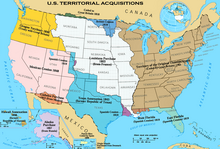
Politically, the U.S. became more democratic with the abolishment of property requirements in voting, although voting remained restricted to white males. By the mid-19th century, the most important issue was slavery. The Northern states generally had outlawed the practice, while the Southern states not only had kept it legal but came to feel it was essential to their way of life. As new states joined the union, lawmakers clashed over whether they should be slave states or free states. In 1860, the anti-slavery candidate Abraham Lincoln was elected president. Fearing he would try to outlaw slavery in the whole country, several southern states seceded, forming the Confederate States of America, electing their own president and raising their own army. Lincoln countered that secession was illegal and raised an army to crush the rebel government. The Confederates had a skilled military that even succeeded in invading the northern state of Pennsylvania. However, the war began to turn around, with the defeat of Confederates at Gettysburg, Pennsylvania, and at Vicksburg, which gave the Union control of the important Mississippi River. Union forces invaded deep into the South, and the Confederacy's greatest general, Robert E. Lee, surrendered to Ulysses S. Grant of the Union in 1865. After that, the south came under Union occupation, ending the American Civil War. Lincoln was tragically assassinated in 1865, but his dream of ending slavery, exhibited in the wartime Emancipation Proclamation, was carried out by his Republican Party, which outlawed slavery, granted blacks equality and black males voting rights via constitutional amendments. However, although the abolishment of slavery would not be challenged, equal treatment for blacks would be.
Hawaii (1815–1870)
In the early 19th century, missionaries, mostly from America, converted the Hawaiians to Christianity. They were followed by American entrepreneurs who established sugar and pineapple plantations and a well-developed economy on the island, becoming a new ruling class, although the native Hawaiian monarchy continued to rule. Eventually, English-speaking Americans and their descendants made up the majority of Hawaii's population.
Canada (1815–1870)

Following the American Revolution, many Loyalists to Britain fled north to what is today Canada (where they were called United Empire Loyalists). Joined by mostly British colonists, they helped establish early colonies like Ontario and New Brunswick. British settlement in North America increased, and soon there were several colonies both north and west of the early ones in the northeast of the continent, these new ones included British Columbia and Prince Edward Island. Rebellions broke out against British rule in 1837, but Britain appeased the rebels' supporters in 1867 by confederating the colonies into the Dominion of Canada, with its own Prime Minister. Although Canada was still firmly within the British Empire, its people now enjoyed a great degree of self-rule. Canada was unique in the British Empire in that it had a French-speaking province, Quebec, which Britain had gained rule over in the Seven Years' War.
Australia and New Zealand (1815-1870)

Beginning in 1788, Britain began sending convicts to Australia's Sydney cove. These convicts were often petty 'criminals', and represented the population spill-over of Britain's industrial revolution, as a result of the rapid urbanisation and dire crowding of British cities that followed Britain's industrialization. Other convicts were political dissidents, particularly from Ireland. Later, free Britons, Irish, and Germans immigrated to Australia. The Australian gold rushes brought prosperity to the colonies and autonomous democratic parliaments began to be established from the 1850s onward.
The native inhabitants of Australia, called the Aborigines, lived as hunter gatherers before European arrival. The Aborigines were dispossessed by the expansion of European agriculture, and had their population greatly reduced by exposure to old world diseases such as smallpox, to which they had no biological immunity. It was a similar situation when inhabitants of the New world met Europeans in South America, and North America. By 1870, Europeans and their descendants made up the vast majority of Australia's population, and the entire continent was divided into a series of colonies.
The British became involved in New Zealand early in the 19th century. In 1840 Britain signed the Treaty of Waitangi with the natives of New Zealand, the Māori, in which Britain gained sovereignty over the archipelago. As British settlers arrived, clashes resulted and the British fought several wars before defeating the Māori. By 1870, New Zealand had a population made up mostly of Britons and their descendants.
The British Empire (1815–1870)
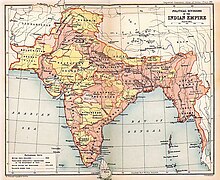
Throughout the 19th century, Britain's empire expanded. All of India was under British rule by 1870. Many Britons settled in India, establishing a ruling class. They then expanded into neighbouring Burma.
In the Far East, Britain went to war with China when it tried to stop Britain from selling the dangerous drug opium to the Chinese people. The First Opium War (1840–1842), ended in a British victory, and China was forced to remove barriers to British trade and cede several ports and the island of Hong Kong to Britain. Soon, other powers sought these same privileges with China and China was forced to agree, ending Chinese isolation from the rest of the world. In 1853 an American expedition opened up Japan to trade with first the U.S., and then the rest of the world.
In 1833 Britain outlawed slavery throughout its empire after a successful campaign by abolitionists, and Britain had a great deal of success attempting to get other powers to outlaw the practice as well.
British settlers continued to arrive in southern Africa. The descendants of the Dutch in southern Africa, called the Boers or Afrikaners, whom Britain had ruled since the Anglo-Dutch Wars, migrated northward, disliking British rule.
Continental Europe (1815–1870)
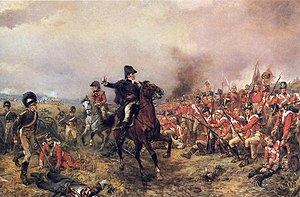
The years following the Napoleonic Wars were a time of change in Europe. The Industrial Revolution, nationalism, and several political revolutions transformed the continent.
Industrial technology was imported from Britain. The first lands affected by this were France, the Low Countries, and western Germany. Eventually the Industrial Revolution spread to other parts of Europe. Many people in the countryside migrated to major cities like Paris, Berlin, and Amsterdam, which were connected like never before by railroads. Europe soon had its own class of wealthy industrialists, and large numbers of industrial workers. New ideologies emerged as a reaction against perceived abuses of industrial society. Among these ideologies were socialism and the more radical communism, created by the German Karl Marx. According to communism, history was a series of class struggles, and at the time industrial workers were pitted against their employers. Inevitably the workers would rise up in a worldwide revolution and abolish private property, according to Marx. Communism was also atheistic, since, according to Marx, religion was simply a tool used by the dominant class to keep the oppressed class docile.
Several revolutions occurred in Europe following the Napoleonic Wars. The goal of most of these revolutions was to establish some form of democracy in a particular nation. Many were successful for a time, but their effects were often eventually reversed. Examples of this occurred in Spain, Italy, and Austria. Several European nations stood steadfastly against revolution and democracy, including Austria and Russia. Two successful revolts of the era were the Greek and Serbian wars of independence, which freed those nations from Ottoman rule. Another successful revolution occurred in the Low Countries. After the Napoleonic Wars, the Netherlands was given control of modern-day Belgium, which had been part of the Holy Roman Empire. The Dutch found it hard to rule the Belgians, due to their Catholic religion and French language. In the 1830s, the Belgians successfully overthrew Dutch rule, establishing the Kingdom of Belgium. In 1848 a series of revolutions occurred in Prussia, Austria, and France. In France, the king, Louis-Philippe, was overthrown and a republic was declared. Louis Napoleon, nephew of Napoleon I was elected the republic's first president. Extremely popular, Napoleon was made Napoleon III (since Napoleon I's son had been crowned Napoleon II during his reign), Emperor of the French, by a vote of the French people, ending France's Second Republic. Revolutionaries in Prussia and Italy focused more on nationalism, and most advocated the establishment of unified German and Italian states, respectively.
In the city-states of Italy, many argued for a unification of all the Italian kingdoms into a single nation. Obstacles to this included the many Italian dialects spoken by the people of Italy, and the Austrian presence in the north of the peninsula. Unification of the peninsula began in 1859. The powerful Kingdom of Sardinia (also called Savoy or Piedmont) formed an alliance with France and went to war with Austria in that year. The war ended with a Sardinian victory, and Austrian forces left Italy. Plebiscites were held in several cities, and the majority of people voted for union with Sardinia, creating the Kingdom of Italy under Victor Emmanuel II. In 1860, the Italian nationalist Garibaldi led revolutionaries in an overthrow of the government of the Kingdom of the Two Sicilies. A plebiscite held there resulted in a unification of that kingdom with Italy. Italian forces seized the eastern Papal States in 1861. In 1866 Venetia became part of Italy after Italy's ally, Prussia, defeated that kingdom's rulers, the Austrians, in Austro-Prussian War. In 1870, Italian troops conquered the Papal States, completing unification. Pope Pius IX refused to recognize the Italian government or negotiate settlement for the loss of Church land.
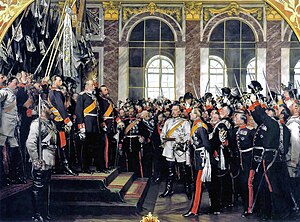
Prussia in the middle and late parts of the 19th century was ruled by its king, Wilhelm I, and its skilled chancellor, Otto von Bismarck. In 1864, Prussia went to war with Denmark and gained several German-speaking lands as a result. In 1866, Prussia went to war with the Austrian Empire and won, and created a confederation of it and several German states, called the North German Confederation. From 1870–1871, Prussia was at war with France. Prussia won the war and gained two border territories, Alsace and Lorraine, from France. After the war, Wilhelm took the title kaiser from the Roman title caesar, proclaimed the German Empire, and all the German states other than Austria united with this new nation.
After years of dealing with Hungarian revolutionist, whose kingdom Austria had conquered centuries earlier, the Austrian emperor, Franz Joseph agreed to divide the empire into two parts: Austria and Hungary, and rule as both Emperor of Austria and king of Hungary. The new Austro-Hungarian Empire was created in 1867. The two peoples were united in loyalty to the monarch and Catholicism.
There were changes throughout the West in science and culture between 1815 and 1870. In science, Louis Pasteur and Joseph Lister made discoveries about bacteria and its effects on humans. The British biologist Charles Darwin developed the theory of evolution. According to Darwin, only the organisms most able to adapt to their environment survived while others went extinct. Adaptations resulted in changes in certain populations of organisms which could eventually cause the creation of new species. Geologists at the time made discoveries indicating the world was far older than most believed it to be. Early batteries were invented and a telegraph system was also invented, allowing global communication. A major cultural movement was Romanticism, which emphasized emotion and nature, and idealized the Middle Ages. Romantic writers included Sir Walter Scott, Lord Byron, Victor Hugo, and Goethe. Important artists and musicians were Franz Schubert, Richard Wagner, Frédéric Chopin, and John Constable. Gothic architecture also came back in style, as evidenced by Notre Dame Cathedral in Paris and the Houses of Parliament in Britain.
In religion, new churches like the Methodist, Unitarian, and Mormon Churches were founded. In the Anglican Church, the Anglo-Catholic movement began, emphasizing the Catholic traditions of the Church. Many people became less religious in this period, although a majority of people still held traditional Christian beliefs.
Europe in 1870 differed greatly from its state in 1815. Most Western European nations had some degree of democracy, and two new national states had been created, Italy and Germany. Political parties were formed throughout the continent and with the spread of industrialism, Europe's economy was transformed, although it remained very agricultural.
The New Imperialism (1870–1914)
The years between 1870 and 1914 saw the expansion of Western power across the globe. By 1914, the West dominated the entire planet. The major Western players in this New Imperialism were Britain, France, Germany, Italy, and the United States. Two non-Western powers involved in this new era of imperialism were Russia and Japan.
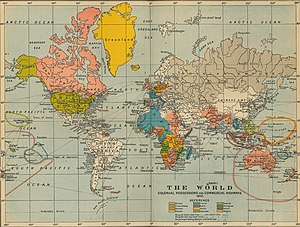
Although the West had had a presence in Africa for centuries, its colonies were limited mostly to Africa's coast. Europeans, including the Britons Mungo Park and David Livingstone, the German Johannes Rebmann, and the Frenchman René Caillé, explored the interior of the continent, allowing greater European expansion in the later 19th century. The period between 1870 and 1914 is often called the Scramble for Africa, due to the competition between European nations for control of Africa. In 1830, France occupied Algeria in North Africa. Many Frenchman settled on Algeria's Mediterranean coast. In 1882 Britain annexed Egypt. France eventually conquered most of Morocco and Tunisia as well. Libya was conquered by the Italians. Spain gained a small part of Morocco and modern-day Western Sahara. West Africa was dominated by France, although Britain ruled several smaller West African colonies. Germany also established two colonies in West Africa, and Portugal had one as well. Central Africa was dominated by the Belgian Congo. At first the colony was ruled by Belgium's king, Leopold II, however his regime was so brutal the Belgian government took over the colony. The Germans and French also established colonies in Central Africa. The British and Italians were the two dominant powers in East Africa, although France also had a colony there. Southern Africa was dominated by Britain. Tensions between the British Empire and the Boer republics led to the Boer Wars, fought on and off between the 1880s and 1902, ending in a British victory. In 1910 Britain united its South African colonies with the former Boer republics and established the Union of South Africa, a dominion of the British Empire. The British established several other colonies in Southern Africa. The Portuguese and Germans also established a presence in Southern Africa. The French conquered the island of Madagascar. By 1914, Africa had only two independent nations, Liberia, a nation founded in West Africa by free black Americans earlier in the 19th century, and the ancient kingdom of Ethiopia in East Africa. Many Africans, like the Zulus, resisted European rule, but in the end Europe succeeded in conquering and transforming the continent. Missionaries arrived and established schools, while industrialists helped establish rubber, diamond and gold industries on the continent. Perhaps the most ambitious change by Europeans was the construction of the Suez Canal in Egypt, allowing ships to travel from the Atlantic to the Indian Ocean without having to go all the way around Africa.
In Asia, China was defeated by Britain in the Opium War and later Britain and France in the Arrow War, forcing it to open up to trade with the West. Soon every major Western power as well as Russia and Japan had spheres of influence in China, although the country remained independent. Southeast Asia was divided between French Indochina and British Burma. One of the few independent nations in this region at the time was Siam. The Dutch continued to rule their colony of the Dutch East Indies, while Britain and Germany also established colonies in Oceania. India remained an integral part of the British Empire, with Queen Victoria being crowned Empress of India. The British even built a new capital in India, New Delhi. The Middle East remained largely under the rule of the Ottoman Empire and Persia. Britain, however, established a sphere of influence in Persia and a few small colonies in Arabia and coastal Mesopotamia.
The Pacific islands were conquered by Germany, the U.S., Britain, France, and Belgium. In 1893, the ruling class of colonists in Hawaii overthrew Hawaii's monarchy - Queen Liliuokalani - and established a republic. Since most of the leaders of the overthrow were Americans or descendants of Americans, they asked to be annexed by the United States, which agreed to the annexation in 1898.
Latin America was largely free from foreign rule throughout this period, although the United States and Britain had a great deal of influence over the region. Britain had two colonies on the Latin American mainland, while the United States, following 1898, had several in the Caribbean. The U.S. supported the independence of Cuba and Panama, but gained a small territory in central Panama and intervened in Cuba several times. Other countries also faced American interventions from time to time, mostly in the Caribbean and southern North America.
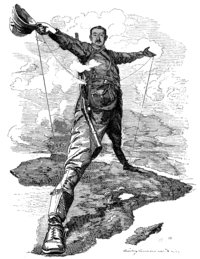
Competition over control of overseas colonies sometimes led to war between Western powers, and between Western powers and non-Westerners. At the turn of the 20th century, Britain fought several wars with the Central Asian country of Afghanistan to prevent it from falling under the influence of Russia, which ruled all of Central Asia excluding Afghanistan. Britain and France nearly went to war over control of Africa. In 1898, the United States and Spain went to war after an American naval ship was sunk in the Caribbean. Although today it is generally held that the sinking was an accident, at the time the U.S. held Spain responsible and soon American and Spanish forces clashed everywhere from Cuba to the Philippines. The U.S. won the war and gained several Caribbean colonies including Puerto Rico and several Pacific islands, including Guam and the Philippines. Important resistance movements to Western Imperialism included the Boxer Rebellion, fought against the colonial powers in China, and the Philippine-American War, fought against the United States, both of which failed.
The Russo-Turkish War (1877–1878) left the Ottoman empire little more than an empty shell, but the failing empire was able to hang on into the 20th century, until its final partition, which left the British and French colonial empires in control of much of the Middle East (British Mandate of Palestine, British Mandate of Mesopotamia, French Mandate of Syria, French Mandate of Lebanon, in addition to the British occupation of Egypt from 1882). Even though this happened centuries after the West had given up its futile attempts to conquer the "Holy Land" under religious pretexts, this fuelled resentment against the "crusaders" in the Islamic world, together with the nationalisms hatched under Ottoman rule contributing to the development of Islamism.
The expanding Western powers greatly changed the societies they conquered. Many connected their empires via railroad and telegraph and constructed churches, schools, and factories. By 1914, even Antarctica was explored by Westerners, and very few parts of the world were not ruled by the West, and those that weren't were often influenced heavily by Western power.
The Great Powers and the First World War (1870–1918)
By the late 19th century, the world was dominated by a few great powers, including Great Britain, the United States, and Germany. France, Russia, Austria-Hungary, and Italy were also great powers.
Western inventors and industrialists transformed the West in the late 19th century and early 20th century. The American Thomas Edison pioneered electricity and motion picture technology. Other American inventors, the Wright brothers, completed the first successful airplane flight in 1903. The first automobiles were also invented in this period. Petroleum became an important commodity after the discovery it could be used to power machines. Steel was developed in Britain by Henry Bessemer. This very strong metal, combined with the invention of elevators, allowed people to construct very tall buildings, called skyscrapers. In the late 19th century, the Italian Guglielmo Marconi was able to communicate across distances using radio. In 1876, the first telephone was invented by Alexander Graham Bell, a British expatriate living in America. Many became very wealthy from this Second Industrial Revolution, including the American entrepreneurs Andrew Carnegie and John D. Rockefeller. Unions continued to fight for the rights of workers, and by 1914 laws limiting working hours and outlawing child labor had been passed in many Western countries.
Culturally, the English-speaking nations were in the midst of the Victorian Era, named for Britain's queen. In France, this period is called the Belle Epoque, a period of many artistic and cultural achievements. The suffragette movement began in this period, which sought to gain voting rights for women. However, by 1914, only a dozen U.S. states had given women this right, although women were treated more and more as equals of men before the law in many countries.
Cities grew as never before between 1870 and 1914. This led at first to unsanitary and crowded living conditions, especially for the poor. However, by 1914, municipal governments were providing police and fire departments and garbage removal services to their citizens, leading to a drop in death rates. Unfortunately, pollution from burning coal and wastes left by thousands of horses that crowded the streets worsened the quality of life in many urban areas. Paris, lit up by gas and electric light, and containing the tallest structure in the world at the time, the Eiffel Tower, was often looked to as an ideal modern city, and served as a model for city planners around the world.
The United States (1870–1914)
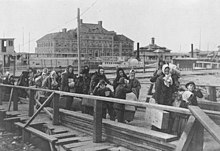
Following the Civil War great changes occurred in the United States. After the war, the former Confederate states were put under federal occupation and federal lawmakers attempted gain equality for blacks by outlawing slavery and giving them citizenship. After several years, however, Southern states began rejoining the Union as their populations pledged loyalty to the United States government, and in 1877 Reconstruction as this period was called, came to an end. After being re-admitted to the Union, Southern lawmakers passed segregation laws and laws preventing blacks from voting, resulting in blacks being regarded as second-class citizens for decades to come.
Another great change beginning in the 1870s was the settlement of the western territories by Americans. The population growth in the American West led to the creation of many new western states, and by 1912 all the land of the contiguous U.S. was part of state, bringing the total to 48. As whites settled the West, however, conflicts occurred with the Amerindians. After several Indian Wars, the Amerindians were forcibly relocated to small reservations throughout the West and by 1914 whites were the dominant ethnic group in the American West. As the farming and cattle industries of the American West matured and new technology allowed goods to be refrigerated and brought to other parts of the country and overseas, people's diets greatly improved and contributed to increased population growth throughout the West.
America's population greatly increased between 1870 and 1914, due largely to immigration. The U.S. had been receiving immigrants for decades but at the turn of the 20th century the numbers greatly increased, due partly to large population growth in Europe. Immigrants often faced discrimination, due to the fact that many differed from most Americans in religion and culture. Despite this, most immigrants found work and enjoyed a greater degree of freedom than in their home countries. Major immigrant groups included the Irish, Italians, Russians, Scandinavians, Germans, Poles and Jews. The vast majority, at least by the second generation, learned English, and adopted American culture, while at the same time contributing to American culture. For example, the celebration of ethnic holidays and the introduction of foreign cuisine to America. These new groups also changed America's religious landscape. Although it remained mostly Protestant, Catholics especially, as well as Jews and Orthodox Christians, increased in number.
The U.S. became a major military and industrial power during this time, gaining a colonial empire from Spain and surpassing Britain and Germany to become the world's major industrial power by 1900. Despite this, most Americans were reluctant to get involved in world affairs, and American presidents generally tried to keep the U.S. out of foreign entanglement.
Europe (1870–1914)
The years between 1870 and 1914 saw the rise of Germany as the dominant power in Europe. By the late 19th century, Germany had surpassed Britain to become the world's greatest industrial power. It also had the mightiest army in Europe.
After the Franco-Prussian War, Napoleon III was dethroned and France was proclaimed a republic. During this time, France was increasingly divided between Catholics and monarchists and anticlerical and republican forces. In 1900, church and state were officially separated in France, although the majority of the population remained Catholic. France also found itself weakened industrially following its war with Prussia due to its loss of iron and coal mines following the war. In addition, France's population was smaller than Germany's and was hardly growing. Despite all this, France's strong sense of nationhood among other things kept the country together.
Between 1870 and 1914, Britain continued to peacefully switch between Liberal and Conservative governments, and maintained its vast empire, the largest in world history. Two problems faced by Britain in this period were the resentment of British rule in Ireland and Britain's falling behind Germany and the United States in industrial production.
The British Dominions (1870–1914)
The populations of Canada, Australia, New Zealand and South Africa all continued to grow and thrive in this period. Canada united as a Dominion of the British Empire under the Constitution Act, 1867 (British North America Acts). The colony of New Zealand gained its own Parliament (General Assembly) and home rule in 1852.[5] and in 1907 was proclaimed the Dominion of New Zealand.[6] During the 1890s, the colonies of Australia voted to unite and in 1901 they were federated as an independent nation under the British Crown as the Commonwealth of Australia. The Heidelberg School of art adapted Western painting techniques to Australian conditions, while writers like Banjo Paterson and Henry Lawson introduced the character of a new continent into English literature. and Australians such as the Opera diva Dame Nellie Melba began to influence the European arts scene. The Constitution of Australia had been drafted in Australia and approved by popular consent. Thus Australia is one of the few countries established by a popular vote.[7] All of these lands became great centers of Western Civilization, each granting voting rights to their citizens in advance of most other Western nations (whith New Zealand and Australian parliaments becoming the first to extend votes to women in the 1890s) Australia also saw such milestones as the invention of the secret ballot, the introduction of a minimum wage, and the election of the world's first Labor Party government.
The New Alliances

The late 19th century saw the creation of several alliances in Europe. Germany, Italy, and Austria-Hungary formed a secret defensive alliance called the Triple Alliance. France and Russia also developed strong relations with one another, due to the financing of Russia's Industrial Revolution by French capitalists. Although it did not have a formal alliance, Russia supported the Slavic Orthodox nations of Eastern Europe, which had been created in the 19th century after several wars and revolutions against the Ottoman Empire, which by now was in decline and ruled only parts of the southern Balkan Peninsula. This Russian policy, called Pan-Slavism, led to conflicts with the Ottoman and Austro-Hungarian Empires, which had many Slavic subjects. Franco-German relations were also tense in this period due to France's defeat and loss of land at the hands of Prussia in the Franco-Prussian War. Also in this period, Britain ended its policy of isolation from the European continent and formed an alliance with France, called the Entente Cordiale. Rather than achieve greater security for the nations of Europe, however, these alliances increased the chances of a general European war breaking out. Other factors that would eventually lead to World War I were the competition for overseas colonies, the military buildups of the period, most notably Germany's, and the feeling of intense nationalism throughout the continent.
World War I
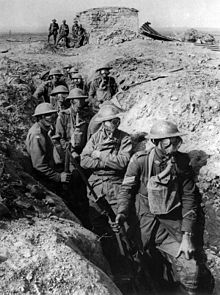
On July 28, 1914, the heir to the Austro-Hungarian throne, Franz Ferdinand, was assassinated by Serbian terrorists in the city of Sarajevo, at the time part of the Austro-Hungarian Empire. When Serbia refused to hand over individuals involved in the assassination, Austria-Hungary declared war, beginning World War I. Fearing the conquest of a fellow Slavic Orthodox nation, Russia declared war on Austria-Hungary. Germany responded by declaring war on Russia as well as France, which it feared would ally with Russia. To reach France, Germany invaded neutral Belgium in August, leading Britain to declare war on Germany. The war quickly stalemated, with trenches being dug from the North Sea to Switzerland. The war also made use of new and relatively new technology and weapons, including machine guns, airplanes, tanks, battleships, and submarines. Even chemical weapons were used at one point. The war also involved other nations, with Romania and Greece joining Britain and France and Bulgaria and the Ottoman Empire joining Germany. The war spread throughout the globe with colonial armies clashing in Africa and Japanese forces, allied with Britain, attacking German bases in the Pacific. In the Middle East, Britain conquered Mesopotamia and Palestine from the Ottomans and supported an Arab revolt against the Ottomans centered in the Arabian Peninsula.
1917 was a crucial year in the war. The United States had followed a policy of neutrality in the war, feeling it was a European conflict. However, during the course of the war many Americans had died on board British ocean liners sunk by the Germans, leading to anti-German feelings in the U.S.. What finally led to American involvement in the war, however, was the discovery of the Zimmermann Telegram, in which Germany offered to help Mexico conquer part of the United States if it formed an alliance with Germany. In April, the U.S. declared war on Germany. The same year the U.S. entered the war, Russia withdrew. After the deaths of many Russian soldiers and hunger in Russia, a revolution occurred against the Czar, Nicholas II. Nicholas abdicated and a Liberal provisional government was set up. In October, Russian communists, led by Vladimir Lenin rose up against the government, resulting in a civil war. Eventually, the communists won and Lenin became premier. Feeling World War I was a capitalist conflict, Lenin signed a peace treaty with Germany in which it gave up a great deal of its Central and Eastern European lands.
Although Germany and its allies no longer had to focus on Russia, the large numbers of American troops and weapons reaching Europe turned the tide against Germany, and after more than a year of fighting, Germany surrendered.
The treaties which ended the war, including the famous Versailles Treaty dealt harshly with Germany and its former allies. The Austro-Hungarian and Ottoman Empires were completely abolished and Germany was greatly reduced in size. Many new nations were created out of the empires, including Poland, Czechoslovakia, and Yugoslavia. The last Austro-Hungarian emperor abdicated, and two new republics, Austria and Hungary, were created. The last Ottoman sultan was overthrown and the Ottoman homeland of Turkey was declared a republic. Germany's kaiser also abdicated and Germany was declared a republic. Germany was also forced to give up the lands it had gained in the Franco-Prussian War to France, accept responsibility for the war, reduce its military and pay reparations to Britain and France.
In the Middle East, Britain gained Palestine, Transjordan (modern-day Jordan), and Mesopotamia as colonies. France gained Syria and Lebanon. An independent kingdom consisting of most of the Arabian peninsula, Saudi Arabia, was also established. Germany's colonies in Africa, Asia, and the Pacific were divided between Britain and France as well.
The war had cost millions of lives and led many in the West to develop a strong distaste for war. Few were satisfied with, and many despised the agreements made at the end of the war. Japanese and Italians were angry they had not been given any new colonies after the war, and many Americans felt the war had been a mistake. Germans were outraged at the state of their country following the war. Also, unlike many in the United States for example, had hoped, democracy did not flourish in the world in the post-war period. The League of Nations, an international organization proposed by American president Woodrow Wilson to prevent another great war from breaking out, proved ineffective, especially due to the fact that the isolationist U.S. wound end up not joining.
The Inter-War Years (1918–1939)
The United States in the Inter-War Years
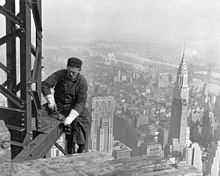
After World War I, most Americans regretted getting involved in world affairs and desired a "return to normalcy". The 1920s were a period of economic prosperity in the United States. Many Americans bought cars, radios, and other appliances with the help of installment payments. Movie theaters sprang up throughout the country, although at first they did not have sound. Also, many Americans invested in the stock market as a source of income. Also in the 1920s, alcoholic beverages were outlawed in the United States. Women were granted the right to vote throughout the United States. Although the United States was arguably the most powerful nation in the post-war period, Americans remained isolationist and elected several conservative presidents in the 1920s.
In October 1929 the New York stock market crashed, leading to the Great Depression. Many lost their life's savings and the resulting decline in consumer spending led millions to lose their jobs as banks and businesses closed. In the Midwestern United States, a severe drought destroyed many farmers' livelihoods. In 1932, Americans elected Franklin Roosevelt president. Roosevelt followed a series of policies which regulated the stock market and banks, and created many public works programs aimed at providing the unemployed with work. Roosevelt's policies helped alleviate the worst effects of the Depression, although by 1941 the Great Depression was still ongoing. Roosevelt also instituted pensions for the elderly and provided money to those who were unemployed. Roosevelt was also one of the most popular presidents in U.S. history, earning re-election in 1936, and also in 1940 and 1944, becoming the only U.S. president to serve more than two terms.
Europe in the inter-war years
Europe was relatively unstable following World War I. Although many prospered in the 1920s, Germany was in a deep financial and economic crisis. Also, France and Britain owed the U.S. a great deal of money. When the United States went into Depression, so did Europe. There were perhaps 30 million people around the world unemployed following the Depression. Many governments helped to alleviate the suffering of their citizens and by 1937 the economy had improved although the lingering effects of the Depression remained. Also, the Depression led to the spread of radical left-wing and right-wing ideologies, like Communism and Fascism.
One of the important political events in Europe at the time was the independence of Ireland. In 1916 militant Irish republicans staged a rising and proclaimed a republic. The rising was suppressed after six days with leaders of the rising executed. This was followed by a war of independence in 1919–1921 and the Irish civil war (1922–1923). After the civil war, the island was divided. Northern Ireland remained part of the United Kingdom, while the rest of the island became the Irish Free State. In 1927 the United Kingdom renamed itself the United Kingdom of Great Britain and Northern Ireland.
In the 1920s the UK was the granting of the right to vote to women.
The Dominions in the inter-war years
The Dominions of the British Empire were also affected by the Depression, although governments attempted to improve their counties' economies. Perhaps the most significant event of the Inter-war years in the Dominions was the passage of the Statute of Westminster, in which Britain effectively granted the Dominions, Australia, New Zealand, Canada, and South Africa independence. However, the new countries kept close ties with Britain, continued to recognize the English monarch as theirs as well, and were key members of the British Commonwealth of Nations.
The rise of totalitarianism
The Inter-war years saw the establishment of the first totalitarian regimes in world history. The first was established in Russia (following the revolution of 1917. The Russian Empire was renamed the Union of Soviet Socialist Republics, or Soviet Union). The government controlled every aspect of its citizens' lives, from maintaining loyalty to the Communist Party to persecuting religion. Lenin helped to establish this state but it was brought to a new level of brutality under his successor, Joseph Stalin.

The first totalitarian state in the West was established in Italy. Unlike the Soviet Union however, this would be a Fascist rather than a Communist state. Fascism is a less organized ideology than Communism, but generally it is characterized by a total rejection of humanism and liberal democracy, as well as very intense nationalism, with government headed by a single all-powerful dictator. The Italian politician Benito Mussolini established the Fascist Party, from which Fascism derives its name following World War I. Fascists won support by many disillusioned Italians, angry over Italy's treatment following World War I. They also employed violence and intimidation against their political enemies. In 1922 Mussolini seized power by threatening to lead his followers on a march on Rome if he was not named Prime Minister. Although he had to share some power with the monarchy, Mussolini ruled as a dictator. Under his rule, Italy's military was built up and democracy became a thing of the past. One important diplomatic achievement of his reign, however, was the Lateran Treaty, between Italy and the Pope, in which a small part of Rome where St. Peter's Basilica and other Church property was located was given independence as Vatican City and the Pope was reimbursed for lost Church property. In exchange, the Pope recognized the Italian government.
Another Fascist party, the Nazis, would take power in Germany. The Nazis were similar to Mussolini's Fascists but held many views of their own. Nazis were obsessed with racial theory, believing Germans to be part of a master race, destined to dominate the inferior races of the world. The Nazis were especially hateful of Jews. Another unique aspect of Nazism was its connection with a small movement that supported a return to ancient Germanic paganism. Adolf Hitler, a World War I veteran, became leader of the party in 1921. Gaining support from many disillusioned Germans, and by using intimidation against its enemies, the Nazi party had gained a great deal of power by the early 1930s. In 1933, Hitler was named Chancellor, and seized dictatorial power. Hitler built up Germany's military in opposition to the Versailles Treaty and stripped Jews of all rights in Germany. Eventually, the regime Hitler created would lead to the Second World War.
In Spain, a republic had been set up following the abdication of the king. After a series of elections, a coalition of republicans, socialists, Marxists, and anticlericals were brought to power. The army, joined by Spanish Conservatives rose up against the republic. In 1939 the Spanish Civil War ended, and General Francisco Franco became dictator. Franco supported the governments of Italy and Germany, although he was not as strongly committed to Fascism as they were and instead focused more on restoring traditionalism and Catholicism to dominance in Spain.
The Second World War and its Aftermath (1939–1950)
The late 1930s saw a series of violations of the Versailles Treaty by Germany, however, France and Britain refused to act. In 1938, Hitler annexed Austria in an attempt to unite all German-speakers under his rule. Next, he annexed a German-speaking area of Czechoslovakia. Britain and France agreed to recognize his rule over that land and in exchange Hitler agreed not to expand his empire further. In a matter of months, however, Hitler broke the pledge and annexed the rest of Czechoslovakia. Despite this, the British and French chose to do nothing, wanting to avoid war at any cost. Hitler then formed a secret non-aggression pact with the Soviet Union, despite the fact that the Soviet Union was Communist and Germany was Fascist. Also in the 1930s, Italy conquered Ethiopia. The Soviets too began annexing neighboring countries. Japan began taking aggressive actions towards China. After Japan opened itself to trade with the West in the mid-19th century, its leaders learned to take advantage of Western technology and industrialized their country by the end of the century. By the 1930s, Japan's government was under the control of militarists who wanted to establish an empire in the Asia-Pacific region. In 1937, Japan invaded China.
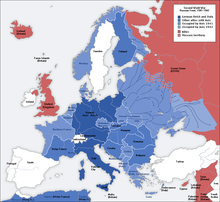
In 1939, German forces invaded Poland, and soon the country was divided between the Soviet Union and Germany. France and Britain declared war on Germany, World War II had begun. The war featured the use of new technologies and improvements on existing ones. Airplanes called bombers were capable of travelling great distances and dropping bombs on targets. Submarine, tank and battleship technology also improved. Most soldiers were equipped with hand-held machine guns and armies were more mobile than ever before. Also, the British invention of radar would revolutionize tactics. German forces invaded and conquered the Low Countries and by June had even conquered France. In 1940 Germany, Italy and Japan formed an alliance and became known as the Axis Powers. Germany next turned its attention to Britain. Hitler attempted to defeat the British using only air power. In the Battle of Britain, German bombers destroyed much of the British air force and many British cities. Led by their Prime Minister, the defiant Winston Churchill, the British refused to give up and launched air attacks on Germany. Eventually, Hitler turned his attention from Britain to the Soviet Union. In June 1941, German forces invaded the Soviet Union and soon reached deep into Russia, surrounding Moscow, Leningrad, and Stalingrad. Hitler's invasion came as a total surprise to Stalin; however, Hitler had always believed sooner or later Soviet Communism and what he believed were the "inferior" Slavic peoples had to be wiped out.
The United States attempted to remain neutral early in the war. However, a growing number feared the consequences of a Fascist victory. So, President Roosevelt began sending weapons and support to the British, Chinese, and Soviets. Also, the U.S. placed an embargo against the Japanese, as they continued to war with China and conquered many colonies formerly ruled by the French and Dutch, who were now under German rule. Japan responded by launching a surprise attack on Pearl Harbor, an American naval base in Hawaii 1941. The U.S. responded by declaring war on Japan. The next day, Germany and Italy declared war on the United States. The United States, Great Britain, and the Soviet Union now comprised the Allies, dedicated to destroying the Axis Powers. Other allied nations included Canada, Australia and China. By 1942, German and Italian armies ruled Norway, the Low Countries, France, the Balkans, Central Europe, part of Russia, and most of North Africa. Japan by this year ruled much of China, South-east Asia, Indonesia, the Philippines, and many Pacific Islands. Life in these empires was cruel — especially in Germany, where The Holocaust was perpetrated. Eleven million people — six million of them Jews — were systematically murdered by the Nazis by 1945.
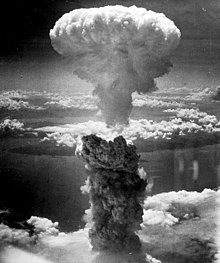
From 1943 on, the Allies gained the upper hand. American and British troops first liberated North Africa from the Germans and Italians. Next they invaded Italy, where Mussolini was deposed by the king and later was killed by Italian partisans. Italy surrendered and came under Allied occupation. After the liberation of Italy, American, British, and Canadian troops crossed the English Channel and liberated Normandy, France, from German rule after great loss of life. The Western Allies were then able to liberate the rest of France and move towards Germany. During these campaigns in Africa and Western Europe, the Soviets fought off the Germans, pushing them out of the Soviet Union all together and driving them out of Eastern and East-Central Europe. In 1945 the Western Allies and Soviets invaded Germany itself. The Soviets captured Berlin and Hitler committed suicide. Germany surrendered unconditionally and came under Allied occupation. The war against Japan continued however. American forces from 1943 on had worked their way across the Pacific, liberating territory from the Japanese. The British also fought the Japanese in such places as Burma. By 1945, the U.S. had surrounded Japan, however the Japanese refused to surrender. Fearing a land invasion would cost one million American lives, the U.S. used a new weapon against Japan, the atomic bomb, developed after years of work by an international team including Germans, in the United States. The U.S. dropped a single bomb on each of the Japanese cities of Hiroshima and Nagasaki, levelling both of them. This, combined with a Soviet invasion of Japanese-occupied Manchuria, led Japan to surrender.
After the war the U.S., Britain and the Soviet Union attempted to cooperate. German and Japanese military leaders responsible for atrocities in their regimes were put on trial and many were executed. The international organization the United Nations was created. Its goal was to prevent wars from breaking out as well as provide the people of the world with security, justice and rights. The period of post-war cooperation ended, however, when the Soviet Union rigged elections in the occupied nations of Eastern Europe to allow for Communist victories. Soon, all of Eastern and much of Central Europe had become a series of Communist dictatorships, all staunchly allied with the Soviet Union. Germany following the war had been occupied by British, American, French, and Soviet forces. Unable to agree on a new government, the country was divided into a democratic west and Communist east. Berlin itself was also divided, with West Berlin becoming part of West Germany and East Berlin becoming part of East Germany. Meanwhile, the former Axis nations soon had their sovereignty restored, with Italy and Japan regaining independence following the war.
World War II had cost millions of lives and devastated many others. Entire cities lay in ruins and economies were in shambles. However, in the Allied countries, the people were filled with pride at having stopped Fascism from dominating the globe, and after the war, Fascism was all but extinct as an ideology. The world's balance of power also shifted, with the United States and Soviet Union being the world's two superpowers.
The Fall of the Western Empires (1945–1970)
Following World War II, the great colonial empires established by the Western powers beginning in early modern times began to collapse. There were several reasons for this. Firstly, World War II had devastated European economies and had forced governments to spend great deals of money, making the price of colonial administration increasingly hard to manage. Secondly, the two new superpowers following the war, the United States and Soviet Union were both opposed to imperialism, so the now weakened European Empires could generally not look to the outside for help.[citation needed] Thirdly, Westerners increasingly were not interested in maintaining and even opposed the existence of empires.[citation needed] The fourth reason was the rise of independence movements following the war. The future leaders of these movements had often been educated at colonial schools run by Westerners where they adopted Western ideas like freedom, equality, self-determination and nationalism, and which turned them against their colonial rulers.[citation needed]
The first colonies to gain independence were in Asia. In 1946, the U.S. granted independence to the Philippines, its only large overseas colony. In British India, Mahatma Gandhi led his followers in non-violent resistance to British rule. By the late 1940s Britain found itself unable to work with Indians in ruling the colony, this, combined with sympathy around the world for Gandhi's non-violent movement, led Britain to grant independence to India, dividing it into the largely Hindu country of India and the smaller, largely Muslim nation of Pakistan in 1947. In 1948 Burma gained independence from Britain, and in 1945 Indonesian nationalist's declared Indonesian independence, which the the Netherlands recognised in 1949 after a four year armed and diplomatic struggle. Independence for French Indochina came only after a great conflict. After the withdrawal of Japanese forces from the colony following World War II, France regained control but found it had to contend with an independence movement that had fought against the Japanese. The movement was led by the Vietnamese Ho Chi Minh, leader of the Vietnamese Communists. Because of this, the U.S. supplied France with arms and support, fearing Communists would dominate South-east Asia.[citation needed] In the end though, France gave in and granted independence, creating Laos, Cambodia, Communist North Vietnam, and South Vietnam.
The most chaotic part of Asia in this period was the Middle East. Following World War II, Britain had granted independence to Mesopotamia, which became Iraq, Kuwait, and Transjordan, which became Jordan. France also granted independence to Syria and Lebanon. British Palestine, however, presented a unique challenge. Following World War I, when Britain gained the colony, based on Zionist ideals Jews mostly from Europe, began immigrating to Palestine. This immigration increased as anti-Semitism in Europe became more prevalent in the 1930s. However, as the numbers of Jewish immigrants to Palestine increased, conflicts with the native Arab Palestinians occurred. The UN proposed Palestine be divided into a Jewish state and an Arab state. The Arabs objected,Britain withdrew and the Zionists declared the state of Israel on the 14th of May 1948. The Palestinians refugees is estimated at 300,000[8] by the time the Arabs neighbors attacked on the 15th of May 1948. Israel won the war in 1948 and subsequent wars followed. Today Israel (based on International consent) occupies the West Bank including East Jerusalem, Shebaa Farms and the Golan heights. Israel maintains a blockade on the Gaza Strip.
The other major center of colonial power, Africa, was freed from colonial rule following World War II as well. Egypt gained independence from Britain and this was soon followed by Ghana and Tunisia. One violent independence movement of the time was fought in Algeria, in which Algerian rebels went so far as to kill innocent Frenchmen. In 1962, however, Algeria gained independence from France. By the 1970s the entire continent had become independent of European rule, although a few southern countries remained under the rule of white colonial minorities.
The end of the Western Empires greatly changed the world. Although many newly independent nations attempted to become democracies, most slipped into military and autocratic rule. Civil war also became a problem, especially in Africa. The loss of overseas colonies partly also led many Western nations, particularly in continental Europe, to focus more on European, rather than global, politics.
The Cold War (1945–1991)
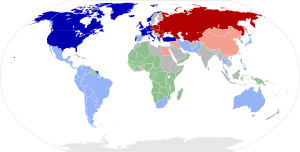
From the end of World War II almost until the start of the 21st century, Western and world politics were dominated by the state of tensions and conflict between the world's two superpowers, the United States and the Soviet Union. In the years following World War II, the Soviets established satellite states throughout Eastern Europe, including historically and culturally Western nations like Poland and Hungary. Following the division of Germany, the East Germans constructed the Berlin Wall, to prevent East Berliners from escaping to the "freedom" of West Berlin. The Berlin Wall would come to represent the Cold War around the world.
Rather than revert to isolationism, the United States took an active role in global politics following World War II to halt Communist expansion. After the war, Communist parties in Western Europe increased in prestige and number, especially in Italy and France, leading many to fear the whole of Europe would become Communist. The U.S. responded to this with the Marshall Plan, in which the U.S. financed the rebuilding of Western Europe and poured money into its economy. The Plan was a huge success and soon Europe was prosperous again, with many Europeans enjoying a standard of living close that in the U.S (following World War II, the U.S. became very prosperous and Americans enjoyed the highest standard of living in the world). National rivalries ended in Europe and most Germans and Italians, for example, were happy to be living under democratic rule, regretting their Fascist pasts. In 1949, the North Atlantic Treaty was signed, creating the North Atlantic Treaty Organization or NATO. The treaty was signed by the United States, Canada, the Low Countries, Norway, Denmark, Iceland, Portugal, Italy, France, and Britain. NATO members agreed that if any one of them were attacked, they would all consider themselves attacked and retaliate. NATO would expand as the years went on, other nations joined, including Greece, Turkey, and West Germany. The Soviets responded with the Warsaw Pact, an alliance which bound Eastern Europe to fight with the Soviets in the event of war.
One of the first actual conflicts of the Cold War took place in China. Following the withdrawal of Japanese troops after World War II, China was plunged into civil war, pitting Chinese Communists against Nationalists, who opposed Communism. The Soviets supported the Communists while the Americans supported the Nationalists. In 1949, the Communists were victorious, proclaiming the Peoples' Republic of China. However, the Nationalists continued to rule the island of Taiwan off the coast. With American guarantees of protection for Taiwan, China did not make an attempt to take over the island. A major political change in East Asia in this period was Japan's becoming a tolerant, democratic society and an ally of the United States. In 1950, another conflict broke out in Asia, this time in Korea. The peninsula had been divided between a Communist North and non-Communist South in 1948 following the withdrawal of American and Soviet troops. In 1950, the North Koreans invaded South Korea, wanting to united the land under Communism. The UN condemned the action, and, because the Soviets were boycotting the organization at the time and therefore had no influence on it, the UN sent forces to liberate South Korea. Many nations sent troops, but most were from America. UN forces were able to liberate the South and even attempted to conquer the North. However, fearing the loss of North Korea, Communist China sent troops to the North. The U.S. did not retaliate against China, fearing war with the Soviet Union, so the war stalemated. In 1953 the two sides agreed to a return to the pre-war borders and a de-militarization of the border area.
The world lived in the constant fear of World War III in the Cold War. Seemingly any conflict involving Communism might lead to a conflict between the Warsaw pact countries and the NATO countries. The prospect of a third world war was made even more frightening by the fact that it would almost certainly be a nuclear war. In 1949 the Soviets developed their first atomic bomb, and soon both the United States and Soviet Union had enough to destroy the world several times over. With the development of missile technology, the stakes were raised as either country could launch weapons from great distances across the globe to their targets. Eventually, Britain, France, and China would also develop nuclear weapons. It is believed that Israel developed nuclear weapons as well.
One major event that nearly brought the world to the brink of war was the Cuban Missile Crisis. In the 1950s a revolution in Cuba had brought the only Communist regime in the Western Hemisphere to power. In 1962, the Soviets began constructing missile sites in Cuba and sending nuclear missiles. Because of its close proximity to the U.S., the U.S. demanded the Soviets withdraw missiles from Cuba. The U.S. and Soviet Union came very close to attacking one another, but in the end came to a secret agreement in which the U.S. withdrew missiles from Turkey in exchange for a Soviet withdrawal of missiles from Cuba.
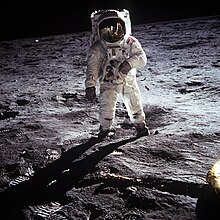
The next great Cold War conflict occurred in Southeast Asia. In the 1960s, North Vietnam invaded South Vietnam, hoping to unite all of Vietnam under Communist rule. The U.S. responded by supporting the South Vietnamese. In 1964, American troops were sent to "save" South Vietnam from conquest, which many Americans feared would lead to Communist dominance in the entire region. The war lasted many years, but most Americans felt the North Vietnamese would be defeated in time. Despite American technological and military superiority, by 1968, the war showed no signs of ending and most Americans wanted U.S. forces to end their involvement. The U.S. undercut support for the North by getting the Soviets and Chinese to stop supporting North Vietnam, in exchange for recognition of the legitimacy of mainland China's Communist government, and began withdrawing troops from Vietnam. In 1972, the last American troops left Vietnam and in 1975 South Vietnam fell to the North. In the following years Communism took power in neighboring Laos and Cambodia.
By the 1970s global politics were becoming more complex. For example, France's president proclaimed France was a great power in and of itself. However, France did not seriously threaten the U.S. for supremacy in the world or even Western Europe. In the Communist world, there was also division, with the Soviets and Chinese differing over how Communist societies should be run. Soviet and Chinese troops even engaged in border skirmishes, although full-scale war never occurred.
The last great armed conflict of the Cold War took place in Afghanistan. In 1979, Soviet forces invaded that country, hoping to establish Communism. Muslims from throughout the Islamic World travelled to Afghanistan to defend that Muslim nation from conquest, calling it a Jihad, or Holy War. The U.S. supported the Jihadists and Afghan resisters, despite the fact that the Jihadists were vehemently anti-Western. By 1989 Soviet forces were forced to withdraw and Afghanistan fell into civil war, with an Islamic fundamentalist government, the Taliban taking over much of the country.

The late 1970s had seen a lessening of tensions between the U.S. and Soviet Union, called Détente. However by the 1980s Détente had ended with the invasion of Afghanistan. In 1981, Ronald Reagan became President of the United States and sought to defeat the USSR by leveraging the United States capitalist economic system to outproduce the communist Russians. The United States military was in a state of low moral after its loss in the Vietnam War, and President Reagan began a huge effort to out-produce the Soviets in military production and technology. In 1985, a new Soviet leader, Mikhail Gorbachev took power. Gorbachev, knowing that the Soviet Union could no longer compete economically with the United States, implemented a number of reforms granting his citizens freedom of speech and introducing some capitalist reforms. Gorbachev and America's staunch anti-Communist president Ronald Reagan were even able to negotiate treaties limiting each side's nuclear weapons. Gorbachev also ended the policy of imposing Communism in Eastern Europe. In the past Soviet troops had crushed attempts at reform in places like Hungary and Czechoslovakia. Now, however, Eastern Europe was freed from Soviet domination. In Poland, democratic elections were held in 1989 bringing to power the ani-Communist Lech Wałęsa. Soon, Communist regimes throughout Europe collapsed. In Germany, after calls from Reagan to Gorbachev to tear down the Berlin Wall, the people of East and West Berlin tore down the wall and East Germany's Communist government was voted out. East and West Germany unified to create the country of Germany, with its capital in the reunified Berlin. The changes in Eastern Europe led to calls for reform in the Soviet Union itself. A failed coup by hard-liners led to greater instability in the Soviet Union, and the Soviet legislature, long subservient to the Communist Party, voted to abolish the Soviet Union in 1991. What had been the Soviet Union was divided into many republics. Although many slipped into authoritarianism, most became democracies. These new republics included Russia, Ukraine, and Kazakhstan. By the early 1990s, the West and Europe as a whole was finally free from Communism.
Following the end of the Cold War, Communism largely died out as a major political movement. The United States was now left as the world's only superpower.
The West: 1945–1980
North America (1945–1980)
Following World War II, there was an unprecedented period of prosperity in the United States. The majority of Americans entered the middle class and moved from the cities into surrounding suburbs, buying homes of their own. Most American households owned at least one car, as well as the relatively new invention, the television. Also, the American population greatly increased as part of the so-called "baby boom" following the war. For the first time following the war, large of numbers of non-wealthy Americans were able to attend college.
Following the war, black Americans started what has become known as the Civil Rights Movement in the United States. After roughly a century of second-class citizenship following the abolishment of slavery, blacks began seeking full equality. This was helped by the 1954 decision by the Supreme Court, outlawing segregation in schools, which was common in the South. Dr. Martin Luther King, a black minister from the South led many blacks and whites who supported their cause in non-violent protests against discrimination. Eventually, the Civil Rights Act and Voting Rights Act were passed in 1964, banning measures that had prevented blacks from voting and outlawing segregation and discrimination in the U.S. By the 1980s, racism had largely died out in the U.S.[citation needed].
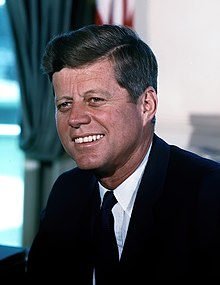
In politics, the Democratic and Republican parties remained dominant. In 1945, the Democratic party relied on Southerners, whose support went back to the days when Democrats defended a state's right to own slaves, and Northeasterners and industrial Mid-Westerners, who supported the pro-labor and pro-immigrant policies of the Democrats. Republicans tended to rely on middle-class Protestants from elsewhere in the country. As the Democrats began championing civil rights, however, Southern Democrats felt betrayed, began voting Republican. Presidents from this period were Harry Truman, Dwight Eisenhower, John Kennedy, Lyndon Johnson, Richard Nixon, Gerald Ford, and Jimmy Carter. The years 1945–1980 saw the expansion of federal power and the establishment of programs to help the elderly and poor pay for medical expenses.
By 1980, many Americans had become pessimistic about their country. Despite its status as one of only two superpowers, the Vietnam War as well as the social upheavals of the 1960s and an economic downturn in the 1970s led America to become a much-less confident nation.
Canada continued to evolve its own national identity in the post-war period. Although it was an independent nation, it remained part of the British Commonwealth and recognized the English monarch as the Canadian monarch as well. Following the war, French and English were recognized as co-equal official languages in Canada, and French became the only official language in the French-speaking province of Quebec. A referendum was held in 1980 in which Quebecers, however, voted not to secede from the union. Other cultural changes Canada faced were similar to those in the United States. Racism and discrimination largely disappeared in the post-war years, and dual-income families became the norm. Also, there was a rejection of traditional Western values by many in Canada. The government also established universal health care for its citizens following the war.
Europe
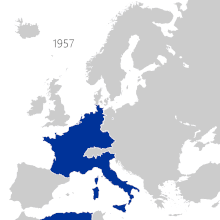
Between 1945 and 1980, Europe became increasingly socialist. Most European countries became welfare states, in which governments provided a large number of services to their people through taxation. By 1980, most of Europe had universal healthcare and pensions for the elderly. The unemployed were also guaranteed income from the government, and European workers were guaranteed long vacation time. Many other entitlements were established, leading many Europeans to enjoy a very high standard of living. By the 1980s, however, the economic problems of the welfare state were beginning to emerge.
Europe had many important political leaders during this time. Charles de Gaulle, leader of the French government in exile during World War II, served as France's president for many years. He sought to carve out for France a great power status in the world sometimes at the expense of the U.S.. In Britain, the first Labour government was elected, and became the major party in the U.K. other than the Conservatives.
Although Europe as a whole was relatively peaceful in this period, both Britain and Spain suffered from acts of terrorism. In Britain, members of the IRA (Irish Republican Army) killed innocent Britons, hoping to unite Northern Ireland with the Republic of Ireland. In Spain, ETA, a Basque separatist group, began committing acts of terror against Spaniards, hoping to gain independence for the Basques, an ethnic minority in north-eastern Spain. Both these terrorist campaigns failed, however.
In 1957 the European Economic Community was formed, consisting of France, Belgium, Italy, Luxembourg, West Germany, and the Netherlands. Eventually, this organization was renamed the European Union or (EU), and many other nations joined, including Britain, Ireland, and Denmark. The EU worked toward economic and political cooperation among European nations.
The last authoritarian dictatorship in Western Europe fell in 1975, when Francisco Franco, dictator of Spain, died. Franco had helped to modernize the country and improve the economy. His successor, King Juan Carlos, transformed the country into a constitutional monarchy. By 1980, all Western nations were democracies.
Australia and New Zealand (1945–1980)
Following World War II, Australia and New Zealand enjoyed a great deal of prosperity along with the rest of the West. Both countries continued to recognize the British monarch as theirs as well, and remained part of the British Commonwealth. However, following British defeats by the Japanese in World War II and the end of Britain's status as one of the most powerful nations on earth, Australia and New Zealand formed an alliance with the U.S..
Western culture (1945–1980)
The West went through a series of great cultural and social changes between 1945 and 1980. Religious observance declined in most of the West. Protestant churches began focusing more on social gospel rather than doctrine, and the ecumenist movement, which supported co-operation among Christian Churches. The Catholic Church changed many of its practices in the Second Vatican Council, including allowing masses to be said in the vernacular rather than Latin. The counterculture of the 1960s (and early 1970s)[9] began in the United States as a reaction against the conservative government, social norms of the 1950s, the political conservatism (and perceived social repression) of the Cold War period, and the US government's extensive military intervention in Vietnam.[10][11]
With the abolishment of laws treating most non-whites as second-class citizens, institutional racism largely disappeared from the West. After gaining equality with men before the law in the West, women began working outside the home, and by 1980 the double-income family became commonplace in Western society. Beginning in the 1960s, many began rejecting traditional Western values, and there was a decline in emphasis on church and the family.
The West (1980–present)
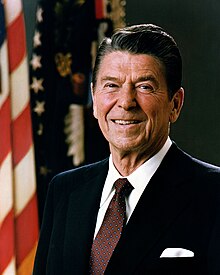
The 1980s were a period of economic growth in the West. The 1990s saw a period of unprecedented prosperity throughout the West. Since 2000, the West has continued to prosper generally but not as much as it did in the 1990s. Global trade became increasingly important, with the World Trade Organization being formed to help manage it. Following the Cold War, the former Soviet republics adopted capitalism, and although China's Communist dictatorship remains in power to this day, its leaders have transformed the country into a capitalist state. Free trade agreements were signed by many countries. The European nations broke down trade barriers with one another in the EU, and the United States, Canada, and Mexico signed the North American Free Trade Agreement (NAFTA). Although free trade has helped businesses and consumers, it has had the unintended consequence of leading companies to outsource jobs to areas where labor is cheapest. Today, the West's economy is largely service and information-based, with most of the factories closing and relocating to China and India.
European countries have had very good relations with each other since 1980. The European Union has become increasingly powerful, taking on roles traditionally reserved for the nation-state. Although real power still exists in the individual member states, one major achievement of the Union was the introduction of the Euro, a currency adopted by most EU countries.
Australia and New Zealand remain part of the Commonwealth of Nations but in both countries there have been calls for a republican form of government. This has been spurred on by Britain's focusing on its relationship with fellow EU nations, while Australians and New Zealanders have been contemplating their future as part of South-east Asia. However, most Australians and New Zealanders desire to remain part of the Commonwealth and keep the monarchy.
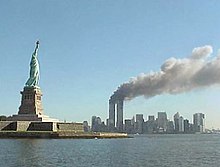
Today Canada remains part of the Commonwealth of Nations, and relations between French and English Canada have continued to present problems. A referendum was held in Quebec, however, in 1980, in which Quebecers voted to remain part of Canada.
Since 1991, the United States has been regarded as the world's only superpower.[12] Politically, the United States is dominated by the Republican and Democratic parties. Presidents of the United States between 1980 and 2006 have been Ronald Reagan, George H.W. Bush, Bill Clinton, and George W. Bush. Since 1980, Americans have become far more optimistic about their country than they were in the 1970s. Since the 1960s, a large number of immigrants have been coming into the U.S., mostly from Asia and Latin America, with the largest single group being Mexicans. Large numbers have also been coming in illegally, and the solution to this problem has produced much debate in the U.S. On September 11, 2001, the United States suffered the worst terrorist attack in its history. Four planes were hijacked by Islamic extremists and crashed into the World Trade Center, the Pentagon, and a field in Pennsylvania.
The West and the world
Following 1991, Western nations provided troops and aid to many war-torn areas of the world. Some of these missions were unsuccessful, like the attempt by the U.S. to provide relief in Somalia in the early 1990s. A very successful peace-making operation was conducted in the Balkans in the late 1990s, however. After the Cold War, Yugoslavia broke up into several countries along ethnic lines, and soon countries and ethnic groups within countries of the former Yugoslavia began fighting one another. Eventually, NATO troops arrived in 1999 and ended the conflict. The greatest war fought by the West in the 1990s, however, was the Persian Gulf War. In 1990, the Middle Eastern nation of Iraq, under its brutal dictator Saddam Hussein, invaded the tiny neighbouring country of Kuwait. After refusing to withdraw troops, the UN condemned Iraq and sent troops to liberate Kuwait. American, British, French, Egyptian and Syrian troops all took part in the liberation. The war ended in 1991, with the withdrawal of Iraqi troops from Kuwait and Iraq's agreement to allow UN inspectors to search for weapons of mass destruction in Iraq.
The West had become increasingly unpopular in the Middle East following World War II. The Arab states greatly disliked the West's support for Israel. Many soon had a special hatred towards the U.S., Israel's greatest ally. Also, partly to ensure stability on the region and a steady supply of the oil the world economy needed, the U.S. supported many corrupt dictatorships in the Middle East. In 1979, an Islamic revolution in Iran overthrew the pro-Western Shah and established an anti-Western Shiite Islamic theocracy. Following the withdrawal of Soviet troops form Afghanistan, most of the country came under the rule of a Sunni Islamic theocracy, the Taliban. The Taliban offered shelter to the Islamic terrorist group Al-Qaeda, founded by the extremist Saudi Arabian exile Osama Bin Laden. Al-Qaeda launched a series of attacks on U.S. overseas interests in the 1990s and 2000. Following the attacks of 9/11, however, the U.S. overthrew the Taliban government and captured many Al Qaeda leaders, greatly harming the group, although Bin Laden has not yet been captured. In 2003, the United States led a controversial war in Iraq, because Saddam had never accounted for all his weapons of mass destruction. By May of that year, American, British, Polish, Spanish, and troops from other countries had defeated and occupied Iraq. Weapons of mass destruction however, were never found afterwards. In both Afghanistan and Iraq, the U.S. and its allies established democratic governments. Following the Iraq war, however, an insurgency made up of a number of domestic and foreign factions has cost many lives and made establishing a government very hard.
Western society and culture (1980–2009)
Between 1980 and 2009, Evangelical Christians grew in number throughout the West, particularly in the United States. Although Evangelical churches did not stress doctrinal issues, most Evangelicals were social conservatives. In general, Western culture has become increasingly secular in Europe, Australia, New Zealand, and Canada. Meanwhile, religion has grown in political influence in the United States.
See also
Notes
- ^ Davies, N. God's Playground A History of Poland Volume 1 Clarendon, 1986 ISBN 0-19-821943-1 Page 4
- ^ Zamoyski, A. The Polish Way John Murray, 1989 ISBN 0-7195-4674-5 Page 10
- ^ Davies, N. God's Playground A History of Poland Volume 1 Clarendon, 1986 ISBN 0-19-821943-1 Page 481-483
- ^ Zamoyski, A. The Polish Way John Murray, 1989 ISBN 0-7195-4674-5 Page 171
- ^ "History, Constitutional - The Legislative Authority of the New Zealand Parliament - 1966 Encyclopaedia of New Zealand". Teara.govt.nz. 2009-04-22. Retrieved 2010-06-11.
- ^ "Dominion status". NZHistory. Retrieved 2010-06-11.
- ^ D.Smith, Head of State, MaCleay Press 2005, p.18
- ^ David Gilmour - Dispossessed: The Ordeal of the Palestinians
- ^ Anderson, Terry H. (1995). The Movement and the Sixties. Oxford University Press. ISBN 0195104579.
- ^ Hirsch, E.D. (1993). The Dictionary of Cultural Literacy. Houghton Mifflin. ISBN 0-395-65597-8. p. 419. "Members of a cultural protest that began in the U.S. in the 1960s and affected Europe before fading in the 1970s...fundamentally a cultural rather than a political protest."
- ^ "Rockin' At the Red Dog: The Dawn of Psychedelic Rock," Mary Works Covington, 2005.
- ^ "Analyzing American Power in the Post-Cold War Era". Retrieved 2007-02-28.
References
- Atlas of World Military History ISBN 0-7607-2025-8 Edited by Richard Brooks
- Almanac of World History by Patricia S. Daniels and Stephen G. Hyslop
- The Millennium Time Tapestry ISBN 0-918223-04-0 by Matthew Hurff
- The Earth and its Peoples ISBN 0-618-42765-1 } Edited by Jean L. Woy
Further reading
- Bruce Thornton, Greek Ways: How the Greeks Created Western Civilization, Encounter Books, 2002
